UMSL Athletics reaches new heights
20




20



Head Coach Josh Alderson chats with the University of Missouri–St. Louis men’s soccer team during halftime of an off-season scrimmage. The Tritons faced off against the St. Louis CITY SC Academy U20 team for a friendly match on Field 3 of the Major League Soccer team’s training facility in the heart of St. Louis. The match was arranged by Alexander Langer, St. Louis CITY SC’s director of goalkeeping and first-team goalkeeper coach, and builds on UMSL’s position as the club’s official higher education partner.



It’s been an exciting year at the University of Missouri–St. Louis. This academic year marked our 60th anniversary of transforming lives through educational excellence, innovative research and service to our communities since our founding in 1963.
Our UMSL community celebrated this milestone with many signature events including Red and Gold Day, in which Tritons and supporters around the globe shared their UMSL pride on social media. Our 60 for 60 initiative shined light on individual alumni who apply our core values in their everyday lives to make the world a better place. We also reached our collective goal to engage in 60,000 hours of volunteerism and service to communities as part of the UMSL Serves initiative.
As we celebrate our past, we remain focused on our future. Nothing embodies this focus more than the Transform UMSL initiative. This bold five-year plan calls for a $110 million investment in our university campus – supported by tremendous private donors as well as the state of Missouri – to bring a renewed and reimagined university to serve our students, region and state for decades to come.
Already this year, we have completed a buildout of the second floor of the Patient Care Center to become the main hub of clinical practice for the College of Optometry and opened a state-of-the-art Geospatial Advanced Technology Lab in Benton Hall. We also completed the demolition of the South J.C. Penney Building to pave the way for the new Richter Family Welcome and Alumni Center and will soon begin work to deconstruct the SSB Tower to make way for new facilities that support the College of Education and Pierre Laclede Honors College.
Spring is truly a time of renewal and change. We too are at an incredible time of renewal and change at UMSL, and you are a vital part of that momentum. You’ve helped define our past 60 years and will no doubt help define our future.
Gratefully forward,
Kristin SobolikA DRAMATIC TRANSFORMATION
OF THE UMSL CAMPUS IS UNDERWAY, WHICH WILL SERVE OUR UNIVERSITY, REGION AND FAR BEYOND FOR DECADES TO COME. STAY UP-TO-DATE WITH THE LATEST TRANSFORM UMSL NEWS.
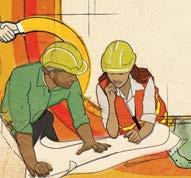
Demolition is complete and construction is set to begin on the Richter Family Welcome and Alumni Center, the new 31,000-square-foot building that will serve as the gateway to UMSL for students, alumni and visitors.
“The campus visit experience is the most important component of our student recruitment efforts,” says Vice Chancellor for Strategic Enrollment Reggie Hill. “Having a modern, dynamic welcome and alumni center positions us to make a strong case with families about their importance to us, as well as the commitment our alumni have to the future of the University of Missouri–St. Louis.”
Resources vital to student success including financial aid, scholarships, new student programs and academic support will be strategically located in the center. It will also be a permanent home for the university’s more than 115,000 alumni, providing ample opportunities for student and alumni connections.
Kirk Richter and family, who provided the namesake gift for the new facility, believed that alumni could and should play an important role in student recruitment, mentoring and engagement. To hear from other donors about the importance of this project in their own words, turn to page 38.
After a nationwide search, Shu Schiller became the new dean of the College of Business Administration on April 1. Schiller, who joined the faculty at Wright State University in 2006, had served as interim dean of its College of Graduate Programs and Honors Studies since November 2022 and before that spent nearly four years as associate dean in the university’s Raj Soin College of Business. At UMSL, she hopes to help build upon the strong reputation of the College of Business Administration throughout the St. Louis region and beyond, including strengthening partnerships with the local business community.

Under Schiller’s leadership, Wright State’s College of Graduate Programs and Honors Studies realized a 3.8% enrollment growth in new domestic students last fall.
Over five decades, the St. Louis Coro Fellows Program, now housed in UMSL’s Community Innovation and Action Center, has developed emerging leaders who work and lead across government, business and nonprofit sectors. The eight fellows in this year’s cohort – Tom Byron, Maxine Gill, Rosa Parks, Noah Pellettieri, Lauren Serfas, Molly Sheridan, Ian Trapp and Cathy Zhu – started the program in September.
Throughout their nine months in the program, they’re due to contribute roughly 10,000 hours combined working on different high-impact projects.
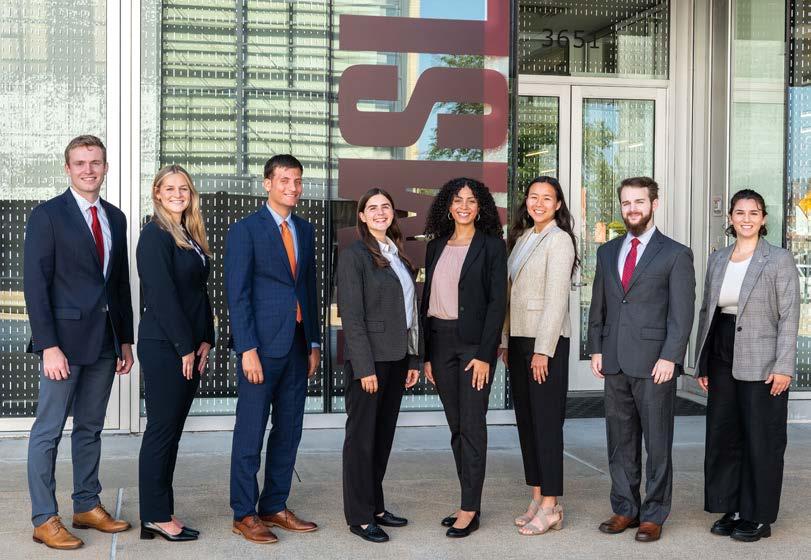
UMSL ATHLETICS
BY THE NUMBERS
2023-24
9
2
1

1
2
3.47
Cumulative
Fall 2023 GPA
252-232-14
Overall combined record
As of press time
Flanagan was instrumental in launching women’s cross country and men’s and women’s track and field teams at UMSL.
Through data visualization and integration, predictive modeling and other aspects, geospatial tools can play a crucial role in advancing knowledge in a range of disciplines. To enhance the scope, quality and impact of geospatial research and applications, UMSL’s Geospatial Collaborative is bringing together experts from diverse fields such as environmental science, public health, engineering and social sciences to leverage their unique perspectives and methodologies toward a common goal. “The idea behind these partnerships is not only to pool resources and expertise but also to foster innovation by crossing traditional disciplinary boundaries,” Director Reda Amer says. “Such collaborations can lead to more comprehensive and robust solutions to problems that no single discipline could solve on its own.” These dynamic geospatial research partnerships are not only pushing the boundaries of academic inquiry but also enhancing practical applications in various fields, such as improving city planning, mapping disease patterns and access to health care and revealing how elevation differences affect segregation patterns.

UMSL launches new Entrepreneurship and Innovation Center
UMSL is expanding the scope of its entrepreneurship program with the launch of its new Entrepreneurship and Innovation Center, with inaugural Director Scott Morris at the helm. Housed under the College of Business Administration, the EIC – which will begin a $3 million renovation of its space on North Campus this summer – will serve as a hub for the innovative Anchor Accelerator program, which supports underrepresented entrepreneurs in St. Louis city and county. Cutting-edge courses in areas such as intrapreneurship and entrepreneurial finance and investment have already been added, and there are also plans for certificate programs, mentorship programs, a speaker series and other events.
At the annual UMSL Sports Hall of Fame induction on Feb. 9, Chancellor Kristin Sobolik surprised Director of Athletics Lori Flanagan when she bestowed her with the very first Chancellor’s Medal. The award recognizes the “indelible impact” Flanagan has made at UMSL over her 18 years at the university, during which UMSL teams have made 53 NCAA Division II regional appearances and won 13 games in NCAA play. Flanagan has also helped secure investments to build competitive athletics facilities and infrastructure, including most recently helping open the new Terry and Stan Freerks Student-Athlete Academic Commons in the Mark Twain Athletic Center. The Chancellor’s Medal will continue to honor members of the UMSL community, including friends and supporters, who have made a significant contribution to advance the mission and values of the university.
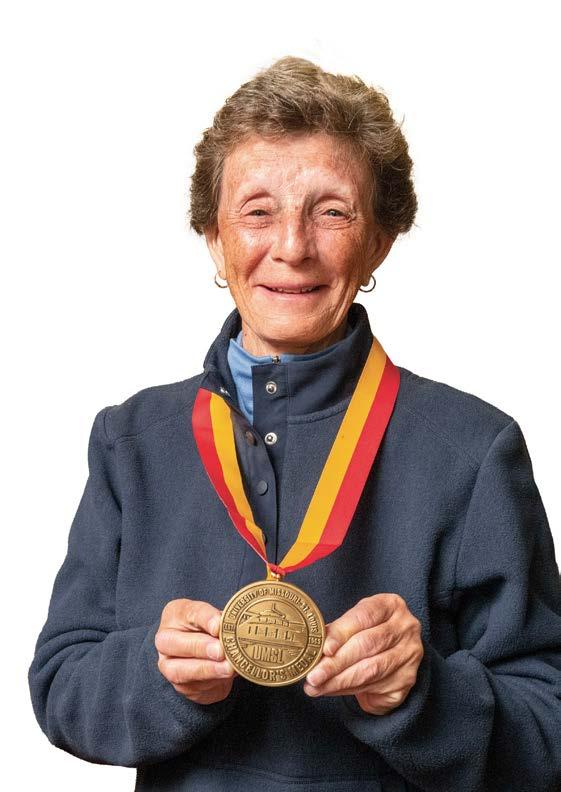
Growing up in post-colonial Uganda in the 1990s, Timothy Makubuya didn’t have access to a school bus. To get to his primary school, where he’d sound the assembly bell every morning as a prefect, he resorted to running the 5 miles – often barefoot. Fitness continued to play a major role in his life as he went on to compete as a distance runner for the Ugandan national team and move to the U.S. to study sports medicine. Interested in exploring how the human brain responds to exercise, his research primarily focuses on physical activity and academic performance, health literacy and teacher and coach education. –TIMOTHY
1
YOUR RESEARCH CENTERS ON FITNESS AND PHYSICAL EDUCATION. WHY DO YOU FIND THESE TOPICS COMPELLING?
I was always fascinated at how euphoric I felt during and after a run. Learning about the unique performance of the human brain during and after a bout of exercise compelled me to further my studies in the teaching and learning processes of physical educators. The childhood obesity epidemic in America was also skyrocketing at the time I arrived in the U.S., which got me thinking about designing physical activity and wellness interventions. As part of my PhD research, I explored the impact that physical inactivity, poor dietary choices and poor sleep patterns had on the body composition of children in the U.S.
2
WHAT IS THE BIGGEST ISSUE YOU HAVE NOTICED IN AMERICAN PHYSICAL EDUCATION?
Physical education has changed as a subject area; it was previously just regarded as “gym class,”
which led to many administrators regarding it as unworthy of time and funding. This de-prioritization continues to impact physical education nationally. The notion of subject competition that values some subjects and not others, coupled with the usual lack of funding, hurts many PE programs across the U.S.
3
WHAT DO YOU SEE AS THE ROLE OF RECREATIONAL FACILITIES ON COLLEGE CAMPUSES? These spaces are key to the improvement of student well-being, which helps improve learning outcomes. They also have the potential to improve employee wellness, as recent evidence reveals that college campus employees who participate in work-related recreation programs have lower medical expenditures and report healthier behaviors.
4
WHAT KIND OF TRAINING SPLIT OR REGIMEN DO YOU CURRENTLY PRACTICE IN YOUR PERSONAL LIFE? Of late, I have varied my training regimen based on where I am. I love the outdoors,

and I enjoy brisk walking, jogging and running. By crosstraining and supplementing these activities with biking and occasional weight training, I’m able to stay on a year-long fitness routine.
5
HOW CAN BUSY STUDENTS OR WORKING PROFESSIONALS IMPROVE THEIR PHYSICAL HEALTH AND WELL-BEING?
Everyone should really try to find 30 to 60 minutes a day for moderate to vigorous aerobic activity. Those who cannot should find creative ways to stay mobile during the week, like parking further away from your destination, and use the weekends to take a brisk walk. It is also important to engage in mindful approaches to wellness as the body, mind and spirit are always in unison. Calming breathing exercises, brain breaks, a simple meditation or prayer could exponentially impact one’s mental faculties and improve learning or work efficiency.
1
HOW DO CONVERSATIONAL AND CLINICAL SPANISH DIFFER?
It’s a very different type of Spanish. There’s so much niche terminology that we don’t even realize that we’re learning. I’ve been studying psychology for 10 years now. That’s a decade of pretty specialized language in English that I had limited exposure to in Spanish. Prior to this program, I would have struggled to speak about fairly basic therapeutic or assessment concepts with a client.
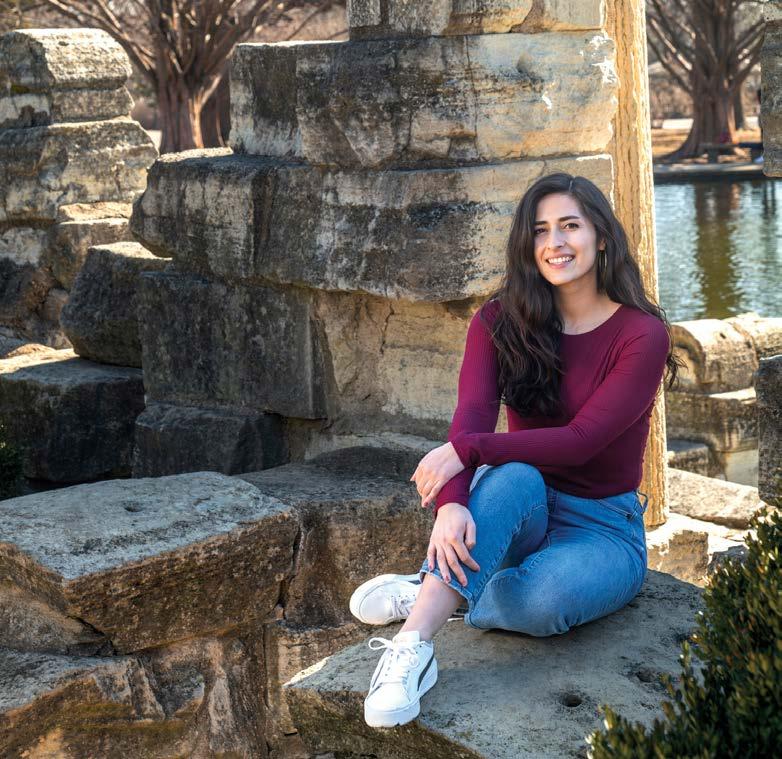
2
WHAT ARE YOU TAKING AWAY FROM THESE EXPERIENCES?
My clinical vocabulary in Spanish has grown tremendously and I’ve gained the confidence I needed to actually do this type of clinical work effectively. It’s one thing to have the knowledge, but it’s easy to feel imposter syndrome when you haven’t had any opportunities to use it and prove to yourself that you can do it well. I also have a better understanding of how I can hopefully supervise bilingual trainees effectively some day in the near future.
Monica Treviño was born in Mexico and grew up speaking Spanish conversationally with her family in Texas, but she wasn’t quite as comfortable providing mental health services in the language. Hoping to strengthen her linguistic and clinical skills to better serve the growing Latinx community, she spent six weeks last summer in Huanchaco, Peru, completing PASEO’s immersion and practicum experience. In October, she attended the National Latinx Psychological Association conference. Now, she’s using what she learned from both experiences to help make the services at UMSL’s Community Psychological Service culturally and linguistically accessible to Spanish speakers. -HEATHER RISKE
3
WHAT HAVE YOU BEEN ABLE TO IMPLEMENT SO FAR? To start, we wanted to at least have some translated psychoeducational materials that we could share with families as they’re waiting for their next treatment touchpoint. We’re getting all of the paperwork, resource packets and referrals ready, making sure that all of our consent forms and HIPAA forms are translated and implementing more standard tools for measuring competency in this area for any future bilingual trainees.
4
WHY IS IT SO IMPORTANT TO MEASURE COMPETENCY? In the field of psychology, there are core competencies for specialized areas of training. We don’t have the same for bilingual psychologists. Having standard competencies and measurement tools is important because it allows us to create effective training programs, empowers people who are able to provide the services and ensures that clients are receiving high-quality care.
5
HOW WOULD YOU LIKE TO SEE THESE SERVICES CONTINUE TO GROW? Being able to have that infrastructure where we already have everything translated and ready to go will make it easier for us to start providing services in Spanish. I am hopeful that we will continue to have new cohorts coming into the program with interest and experience in providing services in Spanish, and it can just keep growing from there.

HOMETOWN: CHARLESTON, MISSOURI
DEGREE: MED IN SECONDARY EDUCATION-ADULT EDUCATION, 1999; MED IN SCHOOL COUNSELING, 2007; EDD IN EDUCATIONAL POLICY AND LEADERSHIP, 2016
CURRENT POSITION: CEO OF GIRL SCOUTS OF EASTERN MISSOURI
FUN FACT: SMALL ENJOYS COOKING AND GARDENING.
BY STEVE WALENTIKIt’s the girls who have provided Natissia Small the most inspiration over the past year since stepping into her role as the CEO of Girl Scouts of Eastern Missouri.
She’s had the privilege of presenting several girls with the prestigious Gold Award for applying all that they’ve learned in their years of scouting to try to help address problems in their communities, and she’s often been able to watch girls showcase real lessons in leadership and entrepreneurship. “It’s been great to watch our girls break through barriers and stand out with their shoulders back and their heads held high,” Small says. “Girl Scouts is so much more than cookies, camp and crafts. Seeing girls develop confidence, leadership skills and a sense of community is the driving force behind what we do.”
As CEO, her day-to-day schedule involves a dynamic mix of strategic organizational oversight and engagement with various stakeholders. Each day brings new opportunities with a blend of unique responsibilities, all aimed at fostering an inclusive and empowering environment for girls, starting as young as age 5 and continuing into adulthood, to thrive. It’s a fulfilling role that Small is honored to hold.
“Girls who participate in any of our services are being prepared for their future,” Small says. “Providing girls with access to resources, exploratory experiences and holistic support through a variety of programming and camps allows them to become the leaders we all need for tomorrow. Our girls learn entrepreneurial skills and strengthen key competencies to promote their ability to be the well-rounded leaders we need today and within our future workforce.”
Those were things that motivated Small throughout her nearly 28 years at the University of Missouri–St. Louis. Much of that time was spent on fostering college and career readiness, including more than a decade directing the Bridge Program, and she ascended to the role of vice provost for access, academic support and workforce integration. Along the way, Small earned three degrees from the university. Small is grateful she gets to continue to help young people build a foundation for future success. Her new role has in some ways widened her reach, as Girl Scouts of Eastern Missouri serves more than 36,000 girls in 28 counties each year. It covers an area that stretches from Kirksville in the north to Pevely in the south and includes a lot of rural communities like where she grew up in Charleston, Missouri.
“Being a part of an organization that recognizes the potential within each individual to be seen, heard and valued,” Small says, “while actively working to provide them with the tools and experiences to unleash their full capabilities, is overwhelmingly fulfilling.”
 BY STEVE WALENTIK
BY STEVE WALENTIK
Adam McBrady found it all a little overwhelming last November when he learned he would be presented with the Friendship Award from the Japan America Society of St. Louis. The organization even surprised him with framed calligraphy meant to be an artistic representation of the words “Urban Chestnut Brewing Company” in kanji.
McBrady was honored for his partnership with JASSTL in his role as the brewery’s hospitality and guest experience manager. It’s been a blessing to be involved given his long-held affinity for Japan and Japanese culture, having fallen in love with the country during a one-month homestay in the town of Chigasaki in high school. That led him to take all the Japanese courses he could while pursuing a degree in history at the University of Missouri–St. Louis, which at the time had not yet launched a degree program in Japanese. He took a study abroad trip to Japan and returned to the country after graduation to teach English.
JASSTL leaders were particularly grateful for the role McBrady played in the brewery’s development of Konomi Ale, a Japanese-inspired ale brewed with rice and matcha and fermented with a sake yeast strain, in collaboration with Masumi Sake to commemorate JASSTL’s 50th anniversary. “Everybody has a pet project, and that’s very much mine,” McBrady says.
The collaboration was born of a conversation at a 2016 beer and sake event with Katsuhiko Miyasaka, whose family has been brewing Masumi Sake in St. Louis’ sister city of Suwa in the Nagano Prefecture of Japan for over 360 years. McBrady remembers sharing the philosophy of Beer Divergency at the heart of Urban Chestnut’s approach to brewing. The brewery aims to share high-quality Americanstyle craft beers through its Revolution Series while also providing beer drinkers classic European brews through its Reverence Series.
“Although we were expressing them in a culturally different manner, a lot of our focus was very much the same – innovating while also preserving the traditions,” McBrady says.
When JASSTL representatives approached Urban Chestnut about brewing a special beer for the anniversary, McBrady and Brewmaster Florian Kuplent went to Miyasaka with a plan to collaborate, and Masumi wound up sharing its Sake #7 Yeast strain to use in the brew.
“I love all of the individual things I’ve done for and with Urban Chestnut and all the individual connections I’ve made with customers over the years,” McBrady says. “But if you’re talking a singular proud moment – being a brewery that at the time was probably only 7 or 8 years old – having them be willing to do a collaboration beer with us was phenomenal.”
HOMETOWN: ST. LOUIS
DEGREE: BS IN HISTORY, 2004
CURRENT POSITION: HOSPITALITY AND GUEST EXPERIENCE MANAGER AT URBAN CHESTNUT BREWING COMPANY
FUN FACT: MCBRADY RECEIVED A HOSPITALITY HERO AWARD FROM EXPLORE ST. LOUIS IN 2021 FOR CALMLY ASSISTING A PANICKED MOTHER WHO’D ACCIDENTALLY LOCKED HER BABY IN THE CAR OUTSIDE UCBC’S GROVE BREWERY AND BIERHALL.
HOMETOWN: ST. LOUIS
DEGREE: BS IN CHEMISTRY, 2009; MBA, 2018
CURRENT POSITION: NORTH AMERICA FOOD AND BEVERAGE REGULATORY LIAISON AT MILLIPORESIGMA
FUN FACT: JEDLICKA ALSO SERVES AS THE CHAIR AND EXECUTIVE BOARD MEMBER OF THE FOOD SCIENCE SECTION OF THE AMERICAN COUNCIL OF INDEPENDENT LABORATORIES.
 BY TIMOTHY WOMBLES
BY TIMOTHY WOMBLES
Justyce Jedlicka has been mixing it up long before studying for her bachelor’s in chemistry at the University of Missouri–St. Louis. Properties of colorful liquids around her home, like shampoo and mouthwash, fascinated the budding child scientist.
“I was always getting in trouble for making concoctions in the kitchen,” Jedlicka recalls, laughing.
Jedlicka’s interest in chemistry grew, eventually culminating in a degree from UMSL. The program taught her what chemists actually do, but most importantly, it made her realize there were opportunities in chemistry beyond the laboratory. At student STEM conferences, amidst the whirl of conversation and discovery, Jedlicka realized she wasn’t going to be in the lab forever.
“I found I was most excited talking about what we were studying,” Jedlicka says. “I realized I had a different role to play in the world.”
After graduation, Jedlicka joined MilliporeSigma, at first in the lab. Thanks to advice from a mentor at the company, she decided to pursue an MBA at UMSL to differentiate herself professionally and gain skills in marketing and communication.
“Within six months,” Jedlicka says, “it opened doors for me.” Jedlicka transitioned from the lab to supporting commercial applications for non-pharma regulated markets. In this role, she communicates with stakeholders, regulators and customers to solve challenges in the world of food safety.
In 2022, when the little-studied but deadly bacteria Cronobacter contaminated infant and toddler formula across the nation, Jedlicka quickly found herself implementing an interdisciplinary blend of scientific expertise and business acumen to examine, publicize and communicate the risks of Cronobacter.
Jedlicka’s efforts – among countless others, she is quick to note – ultimately led to the classification of a Cronobacter infection as a reportable disease, meaning that health providers are legally required to report cases. That’s critical for detecting, monitoring and controlling any outbreaks.
Jedlicka finds her work on Cronobacter to be the most rewarding and impactful experience she’s had so far. She hopes to continue her work facilitating food safety and tackling complex issues at the intersection of science, business and public health.
“If we’re not protecting our most vulnerable,” Jedlicka says, “then what is worth fighting for?”
Over nearly a decade, plugged-in sports fanatics have become familiar with John Nichols’ entertaining insights, freewheeling sense of humor and infectious laugh through an ever-expanding digital media footprint.
For three years, Nichols served as the head of Yahoo!’s NBA social media platforms. He went on to host multiple shows for Buckets, Wave Sports + Entertainment’s basketball vertical, and is currently a co-host on the “Jenkins & Jonez” podcast on Colin Cowherd’s The Volume network and the host of “One More Round” on ESPN.
After graduating from UMSL and then working in the Office of Admissions, Nichols bet on himself and moved to Atlanta in 2016 to attend art school. He began to develop a sizeable following among NBA fans on Twitter, and his sharp wit eventually led to the job with Yahoo!.
Nichols revamped the company’s NBA coverage while writing and hosting social media shows. But when he was approached to serve as lead producer with Buckets, it was just the challenge he needed to keep pushing himself. He was particularly interested in learning to work behind the camera, joking that there’s a “sell-by date” for most on-screen talent.
“Quincy Jones is 91 years old, and he’s still working behind the scenes,” he says. “If you’re producing and you stay hip, stay curious, stay creative, you can do that forever.”
Nichols still worked in front of the camera, hosting shows such as “Outta Pocket” and “Y’all Musta Forgot,” often interviewing the NBA’s biggest personalities about their experiences on and off the court. At first, it was nervewracking, but he compensated with extensive research.
“I was watching video; I was watching tape,” he says. “I’m breaking them down like I’m going to play them in a game.”
Now on “One More Round,” Nichols breaks down boxing’s most iconic fights with the help of pro athletes from the NBA and beyond. While “Jenkins & Jonez” is nominally about sports, Nichols likens the podcast to a variety show, where he and his two co-hosts are just as likely to debate which member of the animal kingdom would come out on top in a battle royale.
In addition to hosting and podcasting, Nichols is working to diversify the game of golf, having recently launched 12 on Mondays, a media brand offering diverse golf content, and All the Homies Playing Golf, an initiative to provide free group golf lessons. The aim is to lower the barrier to entry and create a supportive environment to learn the game.
“People want to diversify the game, but there’s not the people in place to diversify,” he explains. “I love the sport. I want my friends to play the sport with me.”
HOMETOWN: ST. LOUIS
DEGREE: BSBA IN FINANCE,
CURRENT POSITION: VIDEO PRODUCER, PODCASTER, HOST, WRITER
FUN FACT: NICHOLS ONCE INTERVIEWED ACADEMY AWARD WINNER JAMIE FOXX, WHOM HE DESCRIBED AS “THE NICEST GUY EVER.” HE WOULD ALSO LIKE TO DIRECT A MOVIE ONE DAY.

Snow was starting to accumulate outside one Friday morning in February at the University of Missouri–St. Louis, but it still felt almost tropical where Michi Tobler stood, surrounded by rows of fish tanks stacked more than 7 feet high, in Room 101 of the Research Building.
The residents of those tanks – a collection of species gathered from Mexico and parts of Central America – are accustomed to temperatures of more than 80 degrees.
Tobler wants to keep them happy and thriving, so he sets the thermostat accordingly. There are hundreds of them, most not much longer than an AA battery and iridescent, with hues of green, yellow and red shimmering on the top and sides of their slender bodies. Tobler brought them with him from Kansas State University last fall when he assumed his position as the E. Desmond Lee Endowed Professor in Zoological Studies in UMSL’s Department of Biology, and they hold the key to his research.





“We study fish that occur in environments where other fish, or sometimes other animals, don’t really manage to exist,” Tobler says. “We call those extreme environments. There’s some combination of environmental factors that make it almost impossible to hang out. We’ve been using those fish and essentially treating
Tobler was pursuing his master’s degree at the Swiss Federal Institute of Technology Zürich, and he went to Plath’s presentation on fish that live in dark environments.
“It was an amazing talk,” Tobler says. “He was talking about these cave fish in Mexico that live in complete darkness. Within 10,000

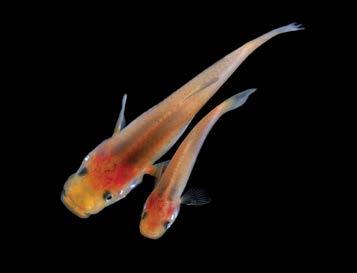
them as a natural experiment. Some of them made it, and they’re thriving in places where nothing or almost nothing else can, so we can ask all sorts of questions about what allows them to push the limits.”
He’s found plenty of funders interested in exploring those questions – and discovering their answers – as well, having received more than $6.8 million in grants from agencies such as the National Science Foundation, the U.S. Department of Defense and the Army Research Office throughout his career.
Tobler’s interest in fish living in extreme environments was first sparked when he attended a scientific talk by biologist Martin Plath in his native Switzerland. At the time,
generations, they had evolved their ability to essentially do things in the darkness that their surface ancestors couldn’t do. He just blew it out of the water.”
Tobler was eager to speak with Plath afterward. “If you ever go to Mexico and you need a guy that just helps you,” Tobler remembers telling him, “I’m your guy.”
Plath wound up calling him about six months later to let him know he’d gotten funding to do field work in Mexico. Tobler joined him there for three weeks, working 16-hour days gathering data on the fish – a type of livebearer from the family Poeciliidae with the scientific name Poecilia mexicana – and their environment.
“I was totally hooked,” he says.
It turned out the cave where the fish lived was not only dark. The water also contained hydrogen sulfide, a toxicant lethal to most living things except the fish and a handful of other creatures.
Tobler was intrigued and wanted to understand how they survived.
For a while, he explored that question on the side, even as he began doctoral research on
unisexual fish while working with his mentor Ingo Schlupp, whom he’d followed from Switzerland to the University of Oklahoma. But eventually, with Schlupp’s blessing, Tobler decided to change course.
“I remember I was so nervous talking to him,” Tobler says. “I was like, ‘Look, I’m not going to write my dissertation about what I’ve been doing the last one and a half or two years. I’m going to write my dissertation about this.’ That’s kind of how it all got started.” •••
Tobler has come to understand how common it is to find organisms thriving in unusual living conditions.
“When you start looking, they’re everywhere,” Tobler says. “There are extreme environments in Missouri. It’s the cave state. There’s lots of weird cave critters here.”
His lab studies a number of fish living under harsh circumstances. One of his doctoral students is interested in looking for patterns in genetic adaptations that occur among different species of cave fish. He also has a master’s student who researches a livebearer fish called the Pecos Gambusia mosquitofish living in high-salinity desert springs in New Mexico as part of a project funded by the U.S. Fish and Wildlife Service.
But Tobler has maintained a particular focus on livebearer fish that have adapted to live in the presence of hydrogen sulfide.
“They’re really great models because they’re super abundant and you can easily keep them in the lab,” he says.
The fish have colonized caves in one particular place in southern Mexico but can be found far more frequently in hydrogen-sulfide-rich surface springs throughout the Americas.
Such pungent-smelling waters are plentiful near Villahermosa in Mexico as well as in Costa Rica, the Dominican Republic and even Florida. The fish that call them home can often be found living less than 100 meters from fresh streams populated with other mollies that appear to be from the same species. There are no obvious characteristic differences except that they can survive where their neighbors cannot.
“They’re just so tough,” Bethany Williams says admiringly.
Williams joined Tobler’s lab as an NSFfunded postdoctoral fellow in August after
earning her PhD in biology at The Ohio State University. She is interested in understanding how multiple stressors impact different organisms in tandem, and she’s found extreme environments – particularly these hydrogensulfide-rich springs and the fish that live in them – to be fertile for that type of work.
“I think they can tell us a lot about what traits they have that are allowing them to survive in there,” Williams says.
That’s been the biggest mystery for Tobler to unlock over the course of two decades studying these fish.
When he first got started, he says he functioned primarily as an ecologist, measuring water levels and keeping tabs on which species made it and which did not.
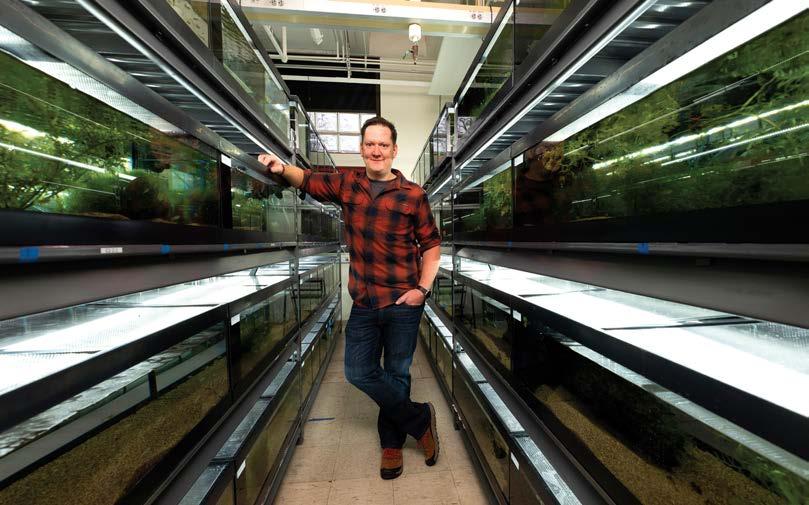
ancestors that developed during a time when hydrogen sulfide was much more common in the environment.
“ When you start looking, they’re everywhere. There are extreme environments in Missouri. It’s the cave state. There’s lots of weird cave critters here.”
–Michi Tobler
He collected plenty of data about the behavior of the fish and could fill a lecture with interesting tidbits of information, but he was missing something important.
“Every single talk I gave,” Tobler says, “the first question people asked was, ‘How do they do it?
How do they survive?’”
At the time, he didn’t know. But the past decade has provided a lot of insight.
In most organisms, hydrogen sulfide proves toxic because, at a cellular level, it binds to a protein in the mitochondria and shuts down the production of adenosine triphosphate, or ATP, which is the energy currency fueling each cell’s activity.
The fish Tobler studies have adapted to continue producing ATP despite the presence of hydrogen sulfide.
He saw two potential explanations. The first was that they’d modified the protein so that hydrogen sulfide could no longer bind with it, shutting off energy production. The other was that the fish’s cells developed a way to eliminate or detoxify the hydrogen sulfide.
Research has shown that many organisms, including humans, can do the latter, at least on a small scale. It’s likely a legacy tool inherited from each organism’s
“These fish have basically upped their pre-existing detoxification pathway,” Tobler says, “so they make a lot more of these proteins that detoxify the sulfide.”
His lab has been able to drill down from the organism level to the organelle, isolating the mitochondria to study how it works, then going down further to learn about the particular proteins involved. They’ve even been able to identify the genes encoding the proteins.
Tobler’s research has led to nearly 130 peerreviewed publications in journals such as Molecular Ecology and the Journal of Evolutionary Biology.
•••
Tobler was as surprised as anyone when he first learned of the biomedical community’s interest in hydrogen sulfide.
“It is a really peculiar substance,” he says. “There was some work in mice that showed that if given just the right amount of hydrogen sulfide, you can induce suspended animationlike states. You basically can put things down to a physiological state where breathing slows down, the heart rate slows down, the body temperature cools down. Then they were able to basically wake up or revive these
mice with no evidence of any sort of cognitive side effects.”
That’s led practitioners connected to the National Institutes of Health and the U.S. military to wonder about potential applications for the substance.
Imagine using hydrogen sulfide at precise levels to slow tissue decay in a donated organ, such as a heart or liver. Could that prolong the window of time to identify a suitable recipient, and could it reduce rejection rates and increase the rate of survival for transplant patients?
Similarly, what if it were possible to administer non-toxic levels of hydrogen sulfide to a soldier who suffers a traumatic injury on a battlefield?
Could that increase the window that exists to get the soldier off the field and to a hospital to receive proper treatment?
The fish Tobler studies are helping to provide some answers.
“If you study a mouse, there’s no such thing as a tolerant mouse,” he says. “All you can study is how the system fails eventually. But we have a beautiful natural experiment. We’ve been able to study how a system fails in the presence of sulfide in these nontolerant fish that live in regular streams, and we can see what those adapted fish are doing and start pinpointing it. What’s the difference in the physiology and the genetics between populations that are probably causing these differential responses? I think that is the power of our system.”
As Tobler knows, there is more to learn.
From left: A front chamber in Cueva del Azufre in Tabasco, Mexico, which has baby-blue water due to sulfur compounds derived from hydrogen sulfide; a pair of cave mollies (Poecilia mexicana), which live in perpetual darkness and in the presence of toxic levels of hydrogen sulfide; Michi Tobler in his lab in the Research Building, which houses around 1,000 fish. (Photos by Robbie Shone and Derik Holtmann)


In partnership with UMSL, the new Living Arts Pathway enlivens lessons at historic Sumner High SchoolBY BURK KROHE
Mack Williams answers questions from all corners of the lively Sumner High School classroom as he moves frOm table to table, project to project.
His students are engaged and working cooperatively at half a dozen spaces, while Williams lends a hand with their history projects, helping nail down a timeline and sorting through Sumner yearbooks of days gone by.
The space, a former art classroom, is specifically designed with an open layout to facilitate working in groups. It has also been transformed into a veritable multimedia production house, with two 3-D printers on one wall, a bank of computers on another, a CNC router machine to create vector-based etchings in the corner and a backroom converted into a studio for video and podcast recordings.

“It’s different from any other classroom in the school,” Williams says. “It’s a different energy.”
It’s all part of the Living Arts Pathway, a new elective museum studies course in which Sumner students research personal and local history, create public exhibits and learn museum and cultural heritage career skills. The course grew from a unique community partnership between 4theVille, a community-based cultural organization working to safeguard the legacy of The Ville neighborhood, and the Museums, Heritage and Public History graduate program at the University of Missouri–St. Louis.
The course, part of a broader Arts Pathways program at the high school, is helping breathe new life into the nearly 150-year-old institution and center of Black life in St. Louis –one that only a few years ago appeared on the brink of closure.
A new beginning
Sumner High School holds a notable place in local and national history as the first high school west of the Mississippi River to educate Black students. During the 20th century, the institution produced numerous cultural luminaries such as Arthur Ashe, Chuck Berry and Tina Turner.
Despite its significance, the school was in danger of closing its doors in 2020 due to low enrollment. Two co-founders of 4theVille, Julia Allen and Thomasina Clarke, were frustrated with that possibility and decided to take action. As Sumner alumni and lifelong residents of The Ville – the historic Black neighborhood surrounding the school’s Cottage Avenue campus – they recognized its cultural and symbolic importance.
“I have yet to tell a Black history story that does not run through The Ville in some form or fashion,” says Aaron Williams, fellow 4theVille co-founder and board chairman. 4theVille rallied local arts and cultural organizations, most notably the St. Louis Shakespeare Festival, to petition the Board of Education of the City of St. Louis to spare the school. The group authored the Sumner High School Recovery Proposal, which suggested injecting arts enrichment programs into the school as a means of increasing enrollment and student engagement. The school board ultimately approved the plan going into the 2021-22 academic year, and the Sumner Advisory Board was formed to oversee the school transformation.
“We were to stand up that program by the start of the second school year,” Williams explains.
He tapped Lara Kelland, the E. Desmond Lee Endowed Professor in Museum Studies and Community History at

UMSL, to help guide the development of the Living Arts Pathway. The pair enlisted Mack Williams, a graduate research assistant in the Department of History, to finalize the curriculum and teach the course at Sumner.
A promising start
Mack Williams was confident he could attract students to museum studies by connecting with them on a personal level, and he was right. The popularity of the course grew by word of mouth during its first year, and soon the class roll was filled. The inaugural cohort also saw early success.
“We had seven projects entered into the National History Day competition for our first year, and five of those seven finished top five in their respective categories,” he says. “Our students, they have the confidence going into this space this year where they know that they belong. They know they can do well. They have a track record of doing well, and we have the experience to build on.”
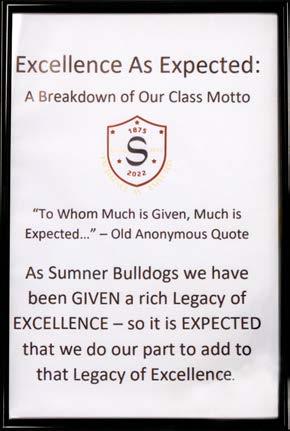
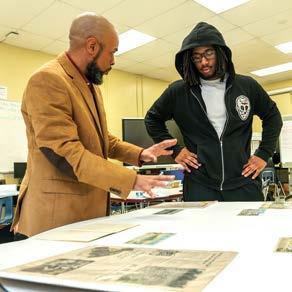
Because of student demand, Williams is teaching two sections this year, a beginner class with 15 students and an intermediate class with 20 students. He adds that he hasn’t had a single disciplinary issue in his classroom in a year and a half. Those results are no accident. They stem from the high expectations Williams sets early with his students, which are further reflected in the class motto, “Excellence as expected.” Principal Ronda Wallace has witnessed the transformative effect of that approach.
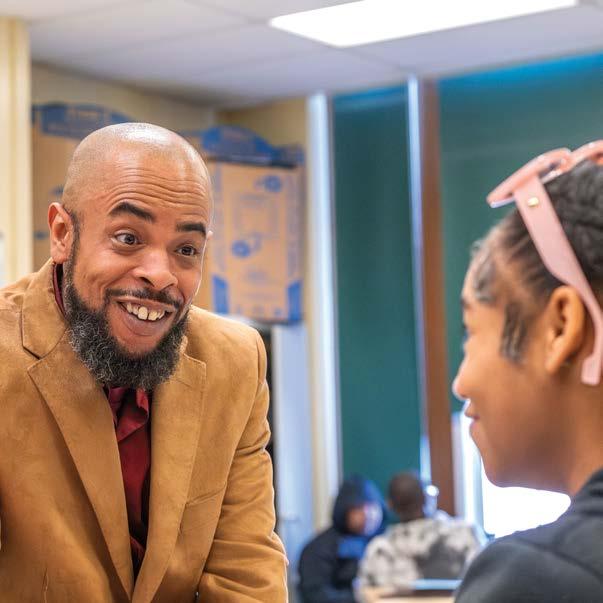
“It’s definitely made an impact on bringing out their natural talents,” Wallace says. “It also played a part in our increased enrollment and our decrease in discipline because they’re really focused on the research. They get focused, and they get excited. Once you provide a program where students are excited, then magic happens.”
and came up with preserving the legacy of our Hall of Fame alumni through transitioning unused locker spaces into museum display spaces.”
Five lockers are dedicated to prominent alumni and are outfitted with plexiglass and lights. The displays include photos, documents from the school archive, digital videos and digital story maps accessible via QR codes. Sophomore Romell Calhoun enjoyed using artifacts connected to Ashe, Turner and Grace Bumbry to tell their stories and says the project opened his eyes to how many great people came out of Sumner.
Students have also begun curating an oral history archive, recording interviews with Sumner alumni from all walks of life. Senior Zea‘Neya Rhone enjoys conducting interviews and has embraced her role as a documentarian.
“This class helps me see the perspective of Sumner alumni,” she says. “You get to make your own history while learning about history.”
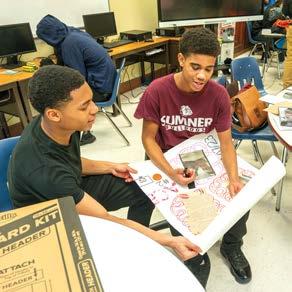
The Living Arts Pathway curriculum is designed carefully to develop buy-in from students. Williams says he identified an “inside-out approach” that starts with a family history project and gradually increases students’ reach into the community. “Each project subsequently expands their exposure,” Williams says. “One of the areas that we wanted to focus on to help facilitate that was genealogy, so we explored the connections between the students and their family journey to get here and make the correlation between that and the Great Migration as a part of the larger African American experience. In addition to that, we started working on projects that connected them with the history of the school.” The students have been empowered to find new and innovative ways to preserve the legacy of Sumner. One of their first successful endeavors involved reimagining Sumner’s “Hall of Fame” – a stretch of hallway with portraits of famous alumni.
“I took our students out into the hallway to look at those portraits, and I challenged them to reexamine what they would do to incorporate a better understanding of who these people are and to better express that in honoring them in the hallways,” Williams says. “We brainstormed with that idea
The interviews also provided Jordan Stewart with an opportunity to develop his skills as a photographer and videographer.
“I didn’t expect to be learning to work a camera the way I know how now,” he says.
“I’m a jack of all trades here. I do everything. I’ve recorded interviews; I’ve taken some nice pictures.”
Students are also free to explore individual passions through their National History Day projects. They have the option to create a documentary video, visual exhibit, research paper, performance or website for the annual competition. Topics vary widely from the legacy of influential rapper 2Pac to Calhoun’s project on the untold story of a Black scientist who began developing rocket schematics in the 1920s.
By telling these stories, the students are cultivating valuable, transferable skills and beginning to see a place for themselves in the museum studies field and beyond. For many, college has become not just a reality but an expectation.
Calhoun says understanding the history of Sumner High School inspires him to pursue his goal of attending the Massachusetts Institute of Technology to study aerospace engineering.
“It made me feel like I can actually do something with my life,” Calhoun says. “They were people who came out of Sumner, then I’m going to be someone who eventually comes out of Sumner. So that means I have a chance of making it and making a great impact on the world just as the people before me did.”
From left: Sumner’s “Hall of Fame” includes a tribute to Sumner alum Warren Bass, the first Black baton twirler at the University of Missouri–Columbia; the class motto and crest, designed by students in the first cohort; Mack Williams chats with students; sophomores Jeremiah Ewing and Adrian Green discuss a project.

In November 2022, the University of Missouri–St. Louis volleyball team won its first-ever NCAA Division II Regional title and reached the national semifinals. Just four months later, the Tritons men’s basketball team won the second regional championship in program history and played in the Elite Eight for the first time in more than 50 years. This past November, the UMSL men’s cross country program qualified its first-ever athlete for the NCAA Championship meet, and in December, the volleyball team went back to the national semifinals for the second straight year.
These past two years have witnessed a string of successes for UMSL Athletics – some unprecedented – led by student-athletes who shine in the classroom as well as in the arena. Here are the stories of six of those athletes.
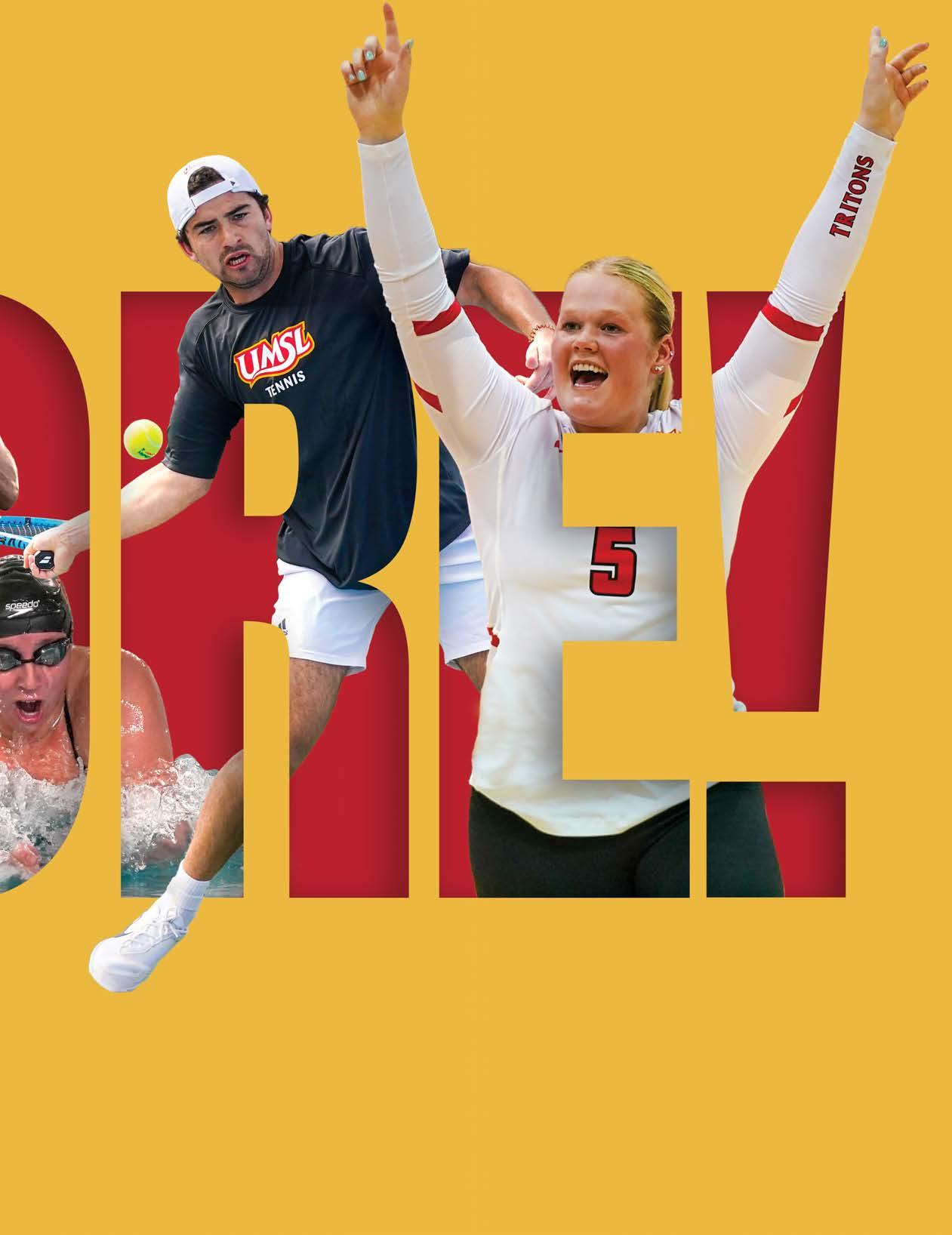 By
By
As a senior at Webster Groves High School – less than 15 miles from UMSL – Matt Enright helped lead his team to a state championship. He was supported by a sizable cheering section of family members and friends along the way. When it came time to choose a college destination, Enright wanted to chase that feeling.
“Through that process, I was able to see how much joy it was for my family to be a part of my journey,” Enright says. “If I had to leave that behind, I couldn’t do it.”
As a freshman last season, Enright stepped straight into a starting spot on a seasoned Tritons team, one that won the program’s first regional title since 1972 and advanced to the NCAA Tournament Elite Eight. As a sophomore this year, Enright is the team’s leading scorer and most prolific 3-point shooter.
He wants to play a crucial part in leading his team back to the bottom of the dogpile he found himself in when the Tritons defeated McKendree University for the regional crown in March 2023.
“Everybody was so happy because we all knew how much work we put in to get to that point,” Enright says. “I think anything’s possible for us, regardless of what the circumstances around it look like. That’s the sort of mentality that I’m able to bring to the table.”
Enright channeled that positivity into creating his own basketball training business, Endure Hoops,
during the height of the COVID-19 pandemic in the summer of 2020. What started as training two youth players in his driveway turned – with some inspiration and guidance from St. Louis native and NBA trainer Drew Hanlen –into a business numbering 50 clients.
Enright feels he is growing as a person and a budding
entrepreneur during his time at UMSL, where he’s a business major.
“I’ve always had that entrepreneurial mindset of ‘I’m going to figure it out,’” Enright says. “I can’t imagine what it would be like anywhere else. It’s special to be able to continue playing in my hometown.”

The defining moment of Jada Holloman’s young Tritons career came thanks to a slippery surface at the University of Illinois Springfield in October.
Holloman and her teammates bested suboptimal field conditions for a 1-0 win over the Prairie Stars that snapped a seven-match losing streak against UIS.
“That was a big turning moment in our season. We came together and fought so hard,” says Holloman, who transferred to UMSL from Division I Loyola Chicago in August. “The bus ride home was an amazing vibe and atmosphere.”
Holloman tied for the team lead in goals during her first season with the Tritons, who posted their best conference record since 2016. The team had 16 first-year players – 13 freshmen and three transfers – on a roster of 28, leading Holloman to believe the team has the ability to grow exponentially next fall in her final year of eligibility.
“This year was a lot of building connections and getting to know each other and the way we play,” she says. “It helped coming in with other players to share that bond of being new to the school.”
Holloman is a biology major on a pre-physician assistant track, with an expected graduation date of May 2025. While she has been a biology major throughout her undergraduate career, the pre-PA track was not available to her until she arrived at UMSL. She first learned about PAs during her Medical Explorers hands-on learning experiences at local hospitals when she was a student at Willard High School in Springfield, Missouri.
“PA felt like something where I can be hands-on and help people,” Holloman says. “There is not a lot of slacking off allowed – at all – in a biology degree, especially when you’re in your junior year and you’re getting into harder classes. All my teachers are very helpful and always there to answer any questions I have in supplemental instruction sessions, just a great supportive team.”

All the normal things –coaching style, team atmosphere, campus feel – enticed Caitlin Bishop to join the Tritons volleyball team from her home in the Kansas City suburb of Lansing, Kansas. The UMSL College of Nursing also lent a sizable assist for the Tritons’ future setter.
“I’ve always been interested in nursing,” Bishop says. “I’ve always loved to be the one to help people get better. I’m not going to be playing volleyball for the rest of my life. Getting a degree from a good school is very important to me, too.”
Although the sophomore, who is majoring in nursing with a minor in psychology, has yet to start clinicals, she thinks she would be a good fit for the emergency room or neonatal intensive care unit.
“I like intensity and in-themoment things, so I think those would be good for me,” she says.
Her play on the volleyball court certainly supports that hypothesis.
As a freshman, Bishop started all 32 matches for a Tritons team that won the program’s first regional title and advanced to the national semifinals. Bishop followed that up this past fall by earning conference and regional Player of the Year and first-team All-America honors for UMSL as it repeated as region champion and national semifinalist and finished with a 34-2 record. With two years left to play, Bishop wants to do her part to leave a legacy.
“I hope to make a name for UMSL volleyball and get my degree but also have fun and make lots of lifelong friends,” she says. “We’re all best friends off the court, hang out with each other and know each other like the backs of our hands. That really helps us out on the court, communication-wise, and with wanting to get better, have these goals set for us and achieve them.”
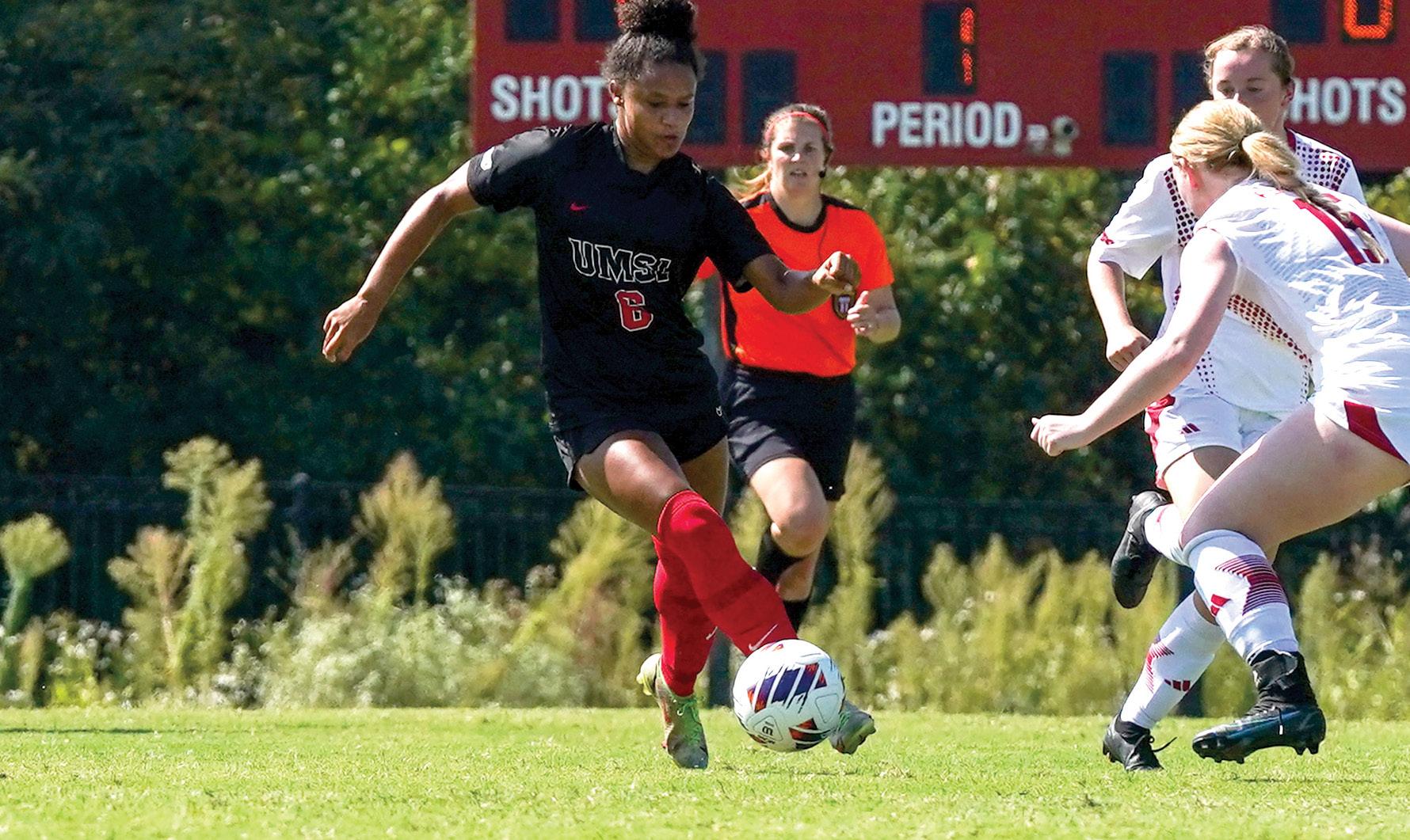

Anative of Quito, Ecuador, Jose Mayorga has been playing tennis since he was 7 years old. Mayorga is now in his final year of eligibility at UMSL, and he is preparing himself for a postgraduate life when the sport he has known so well will recede to a hobby.
Mayorga anticipates that it will be a strange feeling. Luckily, he has a plan once he graduates this May with his degree in civil engineering from the UMSL/Washington University Joint Undergraduate Engineering Program.
Mayorga has worked for the past year and a half as an intern at POWER Engineers and anticipates his role with the company to grow after graduation.
“I like structures: buildings, houses, everything that goes into them,” he says.
Mayorga is continuing a family tradition by pursuing civil engineering. His emphasis is in structural engineering, and his eye
is drawn to the aesthetics of projects.
“I grew up in the industry: my grandfather is an architect, and my father has always been passionate about real estate,” he says. “The classes you take in the UMSL/WashU program are more specialized in your degree. All the projects are very interesting and real-life, situational problems.”
On the court, Mayorga has progressed to become the Tritons’ No. 1 singles player as well as part of the team’s No. 2 doubles pair with sophomore Joshua Mackey, a native of Ireland.
As he looked toward the final months of his competitive tennis career, Mayorga was focused on making lasting memories with his adopted community at UMSL.
“My favorite moments are the friendships I have been able to gather with my team,” he says.
“My goal for this season was to make the best out of it. I feel like I had never been this prepared before to play and compete.”

Coach Steve Picucci’s recruiting pitch to Benjamin VandenBrink centered firmly on the chance to make some history. VandenBrink, coming out of Collegiate School of Medicine & Bioscience in St. Louis in 2020, would be a part of the first UMSL cross country team since the program went dormant in 1983.
He took the opportunity and ran with it, becoming the first runner in Tritons history to qualify for the NCAA Championships this past November. VandenBrink wants to make a return trip this fall, and he
wants the rest of the team to come with him.
“We’re competing at the highest level of the conference as a program and individuals,” he says. “That says something about where the program has gone in four years. From nothing to where we are now has been a huge improvement, a dramatic change. What I and the team are laser-focused on is qualifying for Nationals as a program. This is our shot to go after it before we lose some seniors that have become a big part of the program.”
VandenBrink has one more season of eligibility left in both cross country and track. In the classroom, he graduated with a finance degree in December and has entered the UMSL MBA program.
He first became interested in business after starting his own lawncare and landscaping company as a high-schooler. During his undergraduate career, VandenBrink started working full time as a mortgage loan officer, in addition to his school and sport obligations.
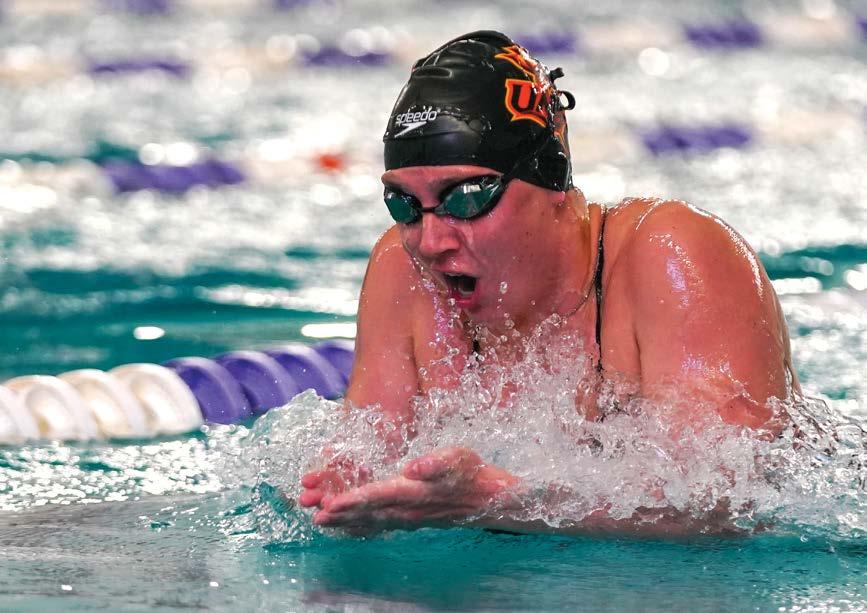
Zara Konstapel believes in the value of pushing herself to try new things.
That certainly applied when she made the decision to travel more than 4,000 miles from her home in Doetinchem, Netherlands, to study and swim at UMSL. It applied when she took on the role
of emcee at the Litmag launch party in the spring of 2022 and when she added a communications minor because of her love of writing. Now, she works part-time at a marketing firm and will be taking on a marketing position at Fieldpiece Instruments after graduation.
“The MBA is going to help me do my job as a loan officer better but also open other future opportunities for my career, whether that be management positions in real estate or lending or a different direction in the world of business or finance,” he says. “I’ve had high-level, top-tier professors who brought a lot of real-world experience into the classroom. I feel like I have secondary experience in a lot of different areas that I gleaned from having experienced professors for four years.”
It continues to apply now, as the senior English major received special permission to take a graduate-level Horror and Rhetoric course to help finish out her degree.
“It’s funny because I’m a rom-com gal,” says Konstapel, who is graduating in May with English
and French degrees. “I am enjoying it; it’s really outside the box. Sometimes, I feel like you have to do things that are outside your little bubble.”
Konstapel has also made a habit of pushing her limits in the pool during five years at UMSL. In March 2022, she became the first Tritons swimmer to ever earn first-team All-America status, with a seventh-place finish in the 100-yard breaststroke at the NCAA Championships. She repeated as a first-team All-American in the 100 breaststroke last year and was an honorable mention All-American in the 100 this year.
She has also helped the medley relays and UMSL swim program reach new heights, with the Tritons earning a top-25 national ranking in February.
“I have loved every single second of it,” Konstapel says. “It’s really exciting making a team on the other side of the world, with two coaches you really don’t know –aside from Zoom meetings – and you take that leap. It’s worked out really well for me.”
 BY HEATHER RISKE
BY HEATHER RISKE
THE COLLEGE OF NURSING’S NEW COMMUNITY-BASED CLINICAL EDUCATION PROGRAM ENABLES FUTURE NURSES TO DELIVER HEALTH CARE IN A VARIETY OF SETTINGSPHOTO ILLUSTRATION BY MARTY BARAGIOLA

Although the clients of Project Compassion were initially skeptical of the turkey tacos, it didn’t take long before they came back for seconds and thirds.
Just before digging in, the group at the Belleville, Illinois-based nonprofit, which offers food, clothing, toiletries, therapy and housing referrals to low-income and unhoused individuals in the community, had recently watched a cooking demonstration by a group of students in the College of Nursing at the University of Missouri–St. Louis.
The students had spent several semesters working with the clients as part of the new CommunityBased Clinical Education program, designed to show students how health care is delivered in a variety of settings outside of the traditional acute care hospital experience. As they got to talking with clients over the course of the program, the students realized how many relied on fast food as a major part of their diet. For their final project in the program, they chose to demonstrate small, sustainable ways to make healthier eating choices.
“It’s greasy food, food that you know you’ll be hungry 30 minutes later,” says one of the students, Brittney Bounds, who graduated in December. “We felt like this was something that we could do to just let them know that you don’t have to be a vegetarian or completely change your diet – just make small substitutions like limiting fast food or substituting beef with turkey. We didn’t do a lot of education because we were more so connecting with them as individuals and not just teaching them. We were more so on their level and interacting with them. We ate together, and we fellowshipped. When we were done, we gave them a survey, and the results were that they are more likely to prepare food at home, and that was the goal.”
Bounds and her classmates were just a few of the nursing students who have been connecting with the
community through the College of Nursing’s CommunityBased Clinical Education program. In building the program, director Sheila Grigsby, an associate professor and the Dean’s Fellow for Community Engagement, sought to better integrate community health into key courses throughout the BSN program each semester. Whereas BSN students were previously only introduced to community and public health concepts in their last semester in the program, the CBCE program intentionally exposes them to nursing in community-based settings throughout their coursework.
All students in the traditional undergraduate BSN program participate in this program, which aims to provide students with unique opportunities to work with an interdisciplinary team of health care providers at various community organizations throughout St. Louis, including Affinia Healthcare, Girls Incorporated of St. Louis, PreventEd, Safe Connections and more.
“Most people spend the majority of their time outside of a hospital setting,” Grigsby says. “There are so many other things that nurses can do outside of being an acute care nurse. We’re able to expose our students to the wide variety of things that nurses can do. If they can, through this experience, understand the importance of building relationships with community organizations but more

importantly with our clients, I think that we’ve achieved what we set out to do. Because that’s how you achieve wellness. That’s how you achieve community satisfaction – through being able to connect with people where they work, live and play, not when they’re in a stressful situation in the hospital. You can make a lifelong impact when you are interacting with them in their own personal settings.”
In their first clinical semester, students are introduced to volunteering and service learning through two in-person experiences. On one Saturday, they volunteer with Food Outreach, helping with food preparation and filling customer orders for the food pantry. They also present on a health topic pre-selected by the residents at Holy Angels I and II, a Cardinal Ritter Senior Services facility. Topics might include skin care and aging, maintaining a healthy weight or urinary incontinence in older adults.
In the following semesters, students are assigned to a community-based clinical agency for 20 hours each semester until their final semester. During this time, in
the Community Health course, they earn 60 hours and visit the agency each week for 12 weeks. After getting to know the organization over the previous semesters, students conduct a large-scale capstone project based on the needs and requests of the agency. At the end of the semester, projects are presented to the agencies as well as the College of Nursing staff, faculty and students during the College of Nursing Research Day. While students previously developed a teaching project during the Health Promotion course, the presentations never left the classroom.
“Now the students are actually preparing something that is going to be utilized in the community,” Grigsby says. “It wasn’t just for a class project; the projects will actually help people in the community.”
Over the program’s first few years, students have worked with many different organizations across St. Louis, all with unique missions and needs. Students have developed projects providing education on a range of topics including healthy eating, diabetes and hypertension management, effective coping skills, maternal health, trauma-informed care and neurodivergence in the classroom.

St. Louis area. Over several semesters working with Affinia and getting to understand patients’ needs, she assisted with HIV testing, vaccinations and sex education and also measured patients’ blood pressure in the hypertension clinic.
For their final project, Carter and her classmates studied the lack of vaccinations in children from birth to 2 years of age and the reasons parents choose not to get their children vaccinated. They found multiple factors at play, including a lack of education and pre- and postnatal care, as well as a mistrust in the health care community more broadly. Seeing the work that Affinia does throughout the community gave her a better
“Nursing goes far beyond the hospital and that’s what we’ve been able to see.”
–Kennady Carter
One group worked with Community Health in Partnership Services hosting monthly blood pressure screenings and glucose screenings at a church in south St. Louis, while another developed a project on car seat safety for Cardinal Glennon Outreach. Yet another group worked with Community Women Against Hardship, providing cooking classes for residents as well as health education and resources centered on vaccinations, exercise, relaxation and diabetes.
Kennady Carter, who is graduating with her BSN this spring, spent her time in the program working with Affinia Healthcare, a federally qualified health center that provides accessible and affordable comprehensive primary and preventive health care across several locations in the
understanding of the way health care is delivered outside of the hospital.
“You don’t realize how many people do things differently than you do until you’re exposed to it,” Carter says. “I didn’t realize how many people used outside clinics, rather than going to a private doctor or a big hospital. Growing up, when I went to my pediatrician, I went to her office. But so many people go to this clinic where it’s basically a one-stop shop – the mom or the dad can see the dentist or the eye doctor and then the baby can see the pediatrician all in one place. It’s really nice to see that nurses are needed in these areas as well and not just in a hospital setting. A lot of times when people see nurses they think, ‘Oh, which hospital do you work at?’ But nursing goes far beyond the hospital and that’s what we’ve been able to see.”
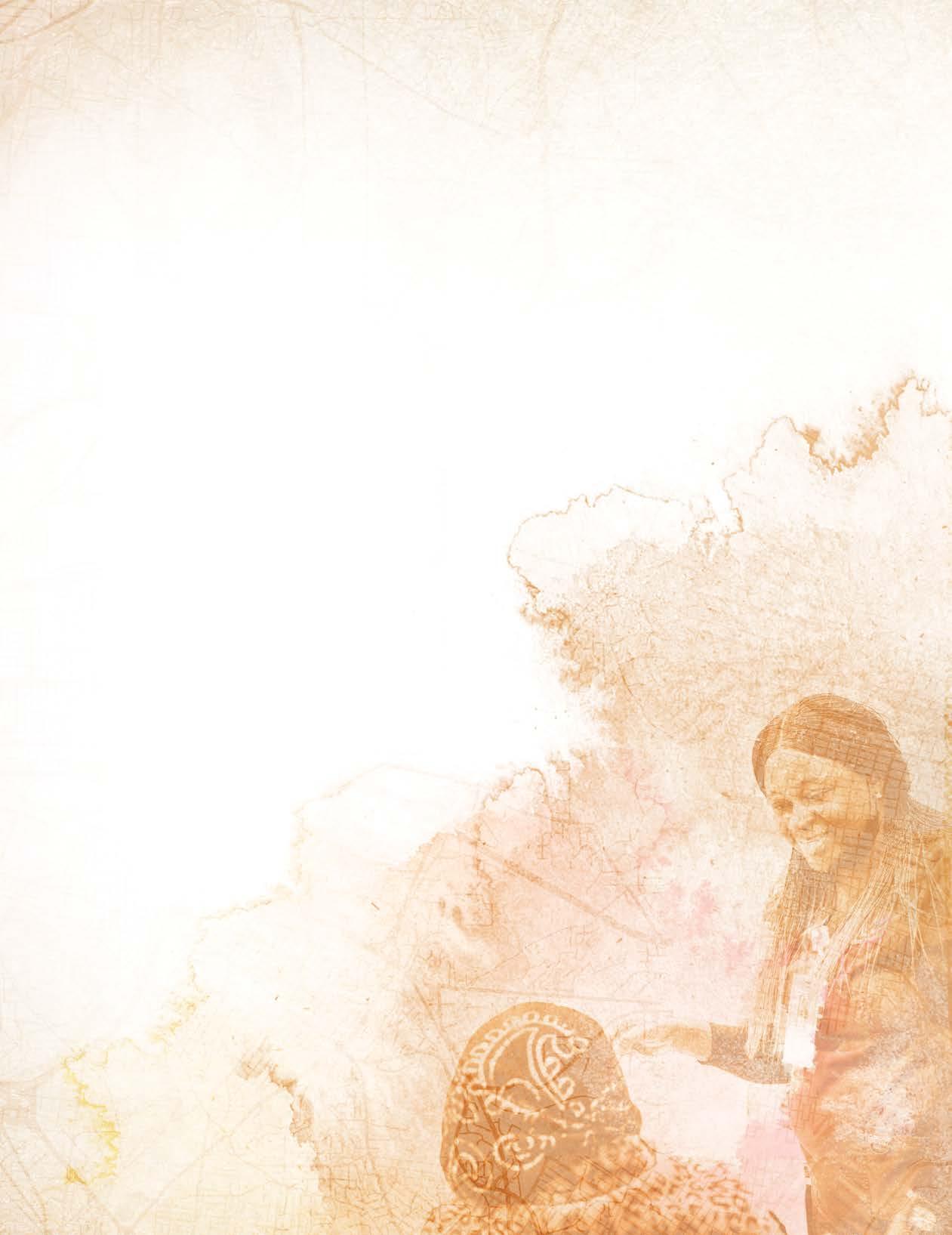
Carter believes that understanding the different settings in which health care is delivered is key to becoming culturally competent and providing patients with an adequate level of care.
“When you go out in clinical and in the community and see what areas you’re needed in, it kind of rekindles that passion and that fire for nursing,” she says. “Having more boots on the ground in the community and helping out in that way will reduce some of those barriers to health care such as the lack of insurance, the lack of prenatal care and the lack of education. When you’re doing the work in the community, it helps educate people before they make it to the hospital and it’s an emergency.”
Students were also encouraged to get creative. December graduate Michelle Liu provided music therapy at a senior facility supported by Faith Parish Nurse Ministries by incorporating health education as she played the guitar. Lindsay Tague, also a December graduate, hosted an art therapy session in which clients of Places for People decorated Mason jars with motivational messages.
“The organizations were excited about having students work with them, but they didn’t understand the potential for how much the students could do,” Grigsby says. “I think that they appreciated the fact that they had the students there for three consecutive semesters, which really decreased the amount of training that they had to provide. The students were able to implement some very innovative programs that they had on their shelves or wish list that they wanted to do but didn’t have time to do.”
T.J. Parker, who graduated with her BSN in December, completed her clinical work with St. Andrew’s Senior Solutions with partner
“Most people spend the majority of their time outside of a hospital setting. There are so many other things that nurses can do outside of being an acute care nurse. We’re able to expose our students to the wide variety of things that nurses can do.”
–Sheila Grigsby
Maddie Malone. She enjoyed getting to know residents as she took their vital signs, tested blood pressure and glucose levels and assisted with medications and dietary questions. For her group’s final project, they taught residents to take their own blood pressure, monitor their glucose levels, make dietary changes and stay active.
Having worked in the operating room as a first assistant since 1993, Parker felt the experience allowed her to bridge the gap between what she was learning in class and put those skills to use in real life. It also offered an opportunity for her to offer a more personalized form of care, and she often returns to The Willows to visit the residents.
“Since I work in the operating room, my patients are usually asleep, so I don’t get the opportunity to see a before and after,” she says. “It allowed me to provide a level of care and then maintain relationships with clients
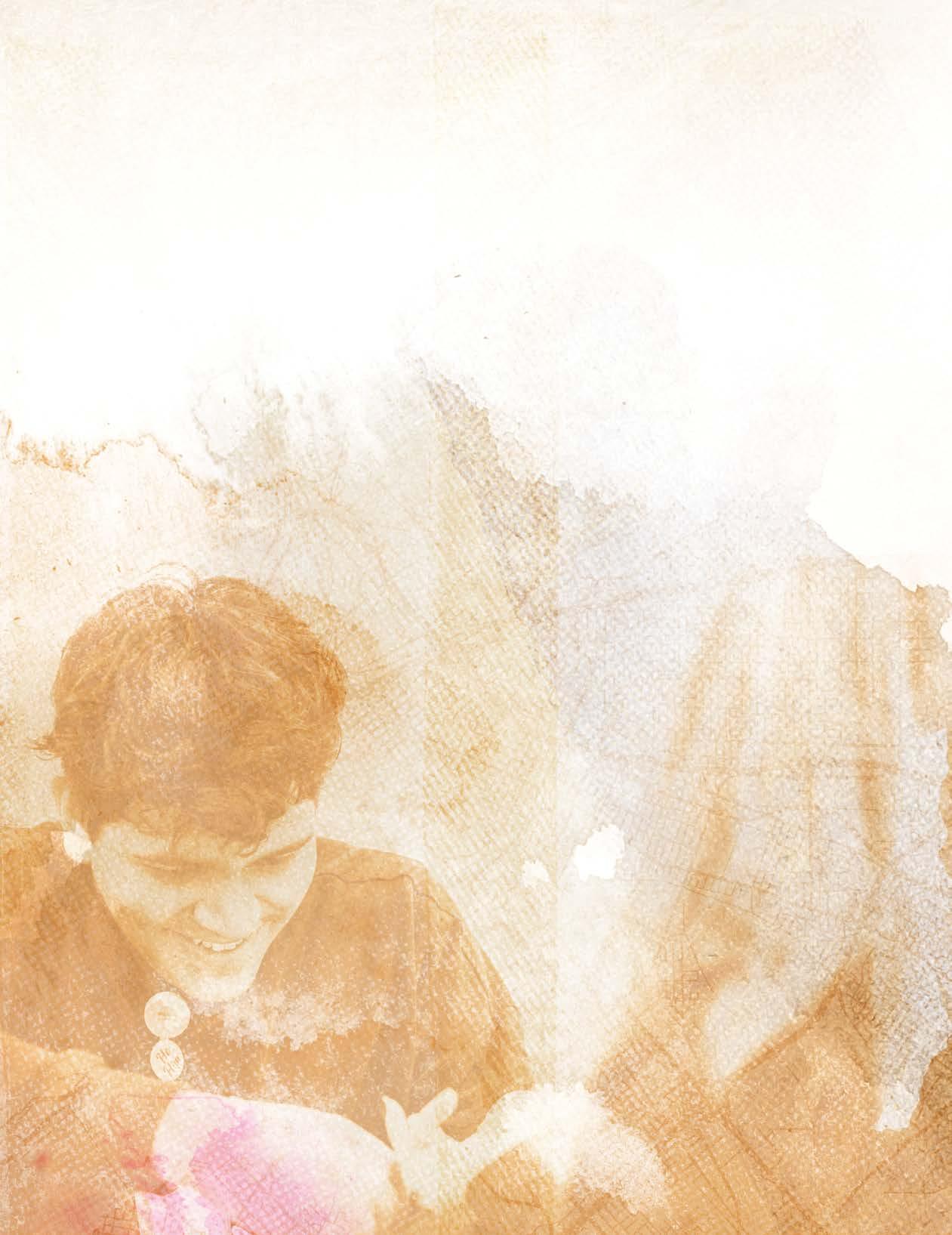
and actually physically see the before and after. I had one client whose blood pressure was extremely high – almost stroke level. Maddie and I walked with her back to her room, and she got her daughter on the phone and went to the hospital. Something was off with her medications, and she had been on the verge of having a stroke, but I was in there and able to see what happened the next week when she was feeling better. I often don’t get to see that.”
Those are exactly the types of experiences that Grigsby and other College of Nursing clinical faculty hope to foster through the CBCE program. They’re continuing to expand and refine the program, which has seen more interest out in the community as word has begun to spread from participating agencies. When Grigsby launched the program in 2021, eight sites were on board – now, that number has grown to 30. The curriculum has also
evolved and will feature three standalone courses by spring 2025.
Grigsby, who has presented the CBCE program to the Association of Community Health Nursing Educators and the American Public Health Nurse Association to positive feedback, hopes to be able to continue to share it outside of the College of Nursing. While similar nursing programs across the country offer opportunities for community health learning, many condense them into a single semester. And with 75% of UMSL graduates staying in the area after graduation, the College of Nursing’s program offers a unique opportunity for students to make an impact in their own communities.
“We’re helping our students know about the community resources that are available in the St. Louis area that can help their clients once they leave nursing school,” Grigsby says. “I think that’s a really unique aspect that we bring because we’re helping to create more well-rounded nurses once they graduate. They know about the hospital settings, but they also know about the community-based health settings as well.
“Students are more comfortable and confident to provide therapeutic conversations and communication with clients outside of a traditional health setting. They really understand social determinants of health – it’s not just a lecture. They’re actually seeing this in real life with real people. So they’re able to make the connections about what that really means and how as nurses they can make an impact with their clients.”
Left to right:
Michael Corry, BSBA 1970, was recently named chair of the Special Education Foundation.
Bob Bone, BSEd 1977, was inducted into the Collinsville Community Unit School District No. 10 Kahok Athletic Hall of Fame.
DeAnn Brunts, BSBA 1985, joined the board of directors of Heritage Grocers.
Michele Dunaway, BSEd 1987, received special recognition for 25 books published with Harlequin Enterprises.
Laura Burkemper, BSBA 1990, co-authored the book “Empathy and Understanding in Business” with Chris Voss.
Mark Deadwyler, MBA 1993, began a new position as chief financial officer with Elemental Enzymes.
Mark Dolitsky, BSBA 1993, began a new position as a design consultant with CTI.
Amy Hunter, BA 1993, PhD 2023, was honored at the 2023 Urban League Salute to Women in Leadership awards.
Jan Lott, MA 1994, began a new position as executive director of human resources with Maryville University.
Stacey Scheinkman, BSBA 1994, began a new position as a project manager/senior analyst in business integration with Mastercard.
Dawn Gerard, BA 1995, was ordained as an elder in full connection within the United Methodist Church.
Rebecca Boyer, BSAcc 1997, began a new position as chief financial officer with ACME Constructors, Inc.
Opal M. Jones, BSBA 2000, MBA 2017, was honored at the 2023 Urban League Salute to Women in Leadership awards.
James E. Jordan Jr., BSAcc 2001, DBA 2020, began a new position as acting deputy administrator with the USDA’s Rural BusinessCooperative Service.

Beth GOETZ, MEd 2001, was named the Henry B. and Patricia B. Tippie Director of Athletics Chair at the University of Iowa. Goetz, who was inducted into the UMSL Sports Hall of Fame in 2014, is the first woman to hold the role and the only female athletic director in the Big Ten, one of the nation’s premier NCAA Division I conferences. A native of Florissant, Missouri, Goetz played collegiate soccer at Clemson University and started coaching women’s soccer while pursuing her master’s in family therapy from the UMSL College of Education before ascending to assistant athletic director.
Gareth Smith, BSBA 2002, began a new position as vice president of business development with Firstsource.
Christopher Lehmuth, BSIS 2003, began a new position as partner in data strategy and intelligence with Turnberry Solutions.
Steven HARRIS, BSBA 2000, has been named the St. Louis American Charitable Foundation 2024 Corporate Executive of the Year. He was honored at the foundation’s 22nd Annual Salute to Business Networking and Awards Luncheon in February. Harris, CPA, CGMA, is managing partner with RubinBrown, one of the nation’s top 50 accounting and business consulting firms.
Jackie HAMILTON, BSBA 1993, was named the 2023 Outstanding Fundraising Executive by the Association of Fundraising Professionals’ St. Louis Regional Chapter. In her role as the assistant director of advancement for the St. Louis County Library, Hamilton helps ensure funding for important programs and resources is available to help members of the community thrive. “St. Louis County Library reaches millions of people in so many different ways,” she says. “The library is so much more than books. From diapers and literacy tools to adult high school education and entrepreneurial launch pads, to healthy meals, digital equity and social workers, SLCL is making a genuine impact in our region.” Hamilton found her career path after a mission dear to her heart – medical research for multiple myeloma – sparked her interest in philanthropy. She has played a vital role in raising over $100 million to empower the St. Louis region through community involvement and professional opportunities.

We
Kevin Meyer, BSIS 2003, began a new position as area director of PMO Strategic Initiatives with World Wide Technology.
Tim Winters, BA 2003, began a new position as an ATC Lab services manager with World Wide Technology.
Andrea Jackson-Jennings, BGS 2004, MEd 2007, EdD 2022, was appointed to the Bi-State Development Agency of the Missouri-Illinois Metropolitan District by Gov. Mike Parson.
Lauren Updike, BSN 2004, began a new position as an RN assessment counselor with CenterPointe Hospital.
Jonathan Lidgus, MEd 2005, was awarded the 2023 State Level Leadership Award by the State of the Art Conference.
Andrew Bohler, BSBA 2008, began a new position as a program manager with ICF.
Shannon Jennings, BSAcc 2009, began a new position as an analyst II in insurance operations with Safety National.
Keith Zoromski, MA 2009, began a new position as provost and vice president of academic affairs of Mineral Area College.
Christina Dancy, BSPPA 2010, began a new position as an assistant vice president and community impact manager for mortgages with U.S. Bank.
Dr. Iesha Draper, BS 2010, began a new position as staff pediatrician with Affinia Healthcare.
Christopher Oppy, BA 2010, MAcc 2021, began a new position as a senior staff accountant with Enterprise Mobility.
Shawnette Thebeau, BA 2010, began a new position as St. Louis site staffing integrator with Boeing. Emily Geest, BLS 2011, was awarded the 2023 Conservation Hero of the Year award at Oklahoma City Zoo and Botanical Gardens for her work with monarch butterflies, community science and launching a plant head start program.
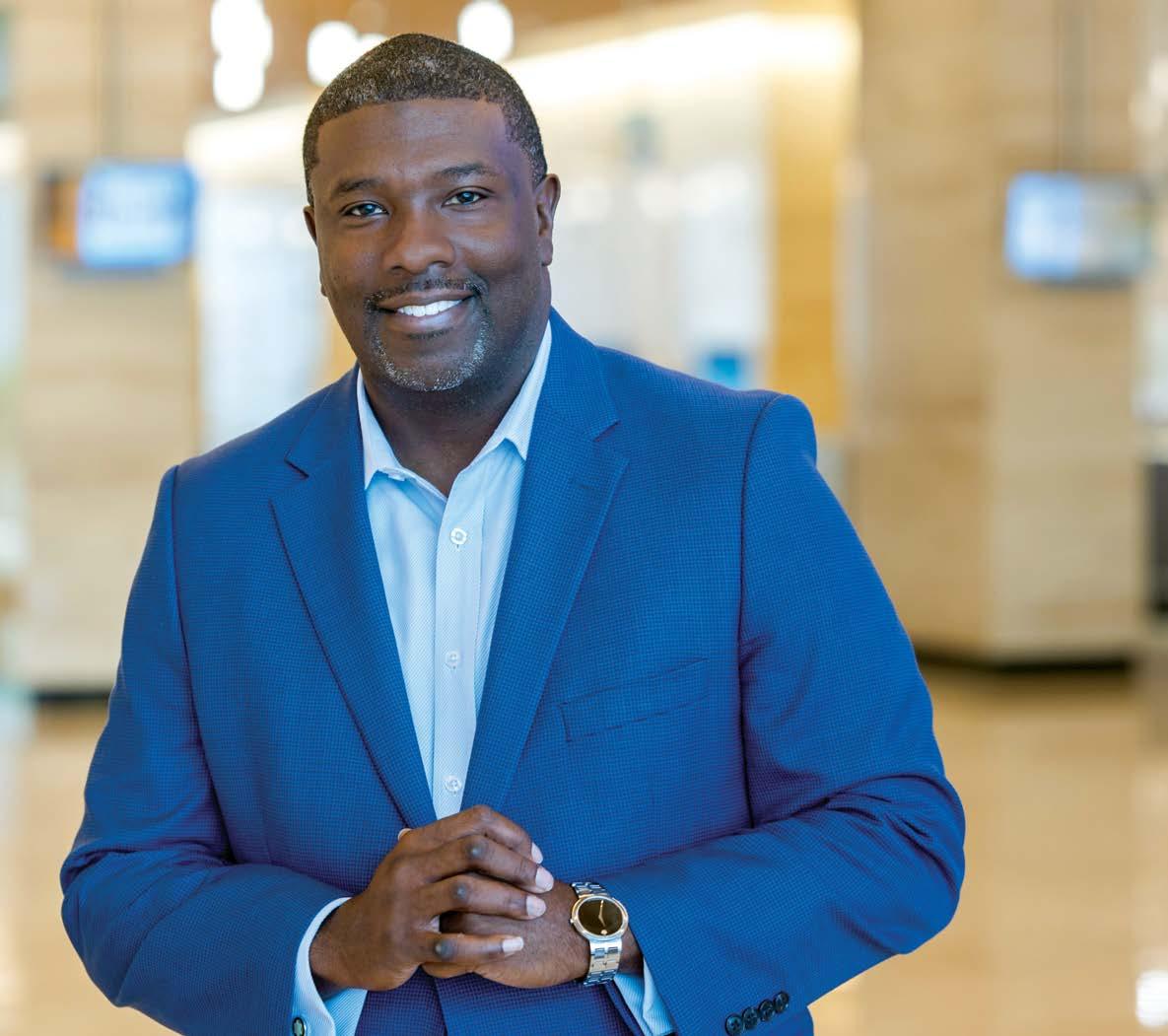
“
QUOTABLE
Steven HarriS, BSBa 2000
I HAVE THE GREAT RESPONSIBILITY TO PROMOTE AND SUSTAIN A "BE OUR BEST FOR OTHERS" CULTURE. "OTHERS" INCLUDES EVERYONE WE COME IN CONTACT WITH: CLIENTS, COLLEAGUES AND ANYONE IN OUR RESPECTIVE COMMUNITIES. HOW WILL WE BE OUR BEST FOR OTHERS TODAY? ”
HOMETOWN: St. Louis
CURRENT LOCATION:
St. Louis
OCCUPATION: Chief Executive Officer at Scaleblazer
Two years ago, Laura Burkemper entered a global negotiations contest for fun and self-improvement. It was an area that she perceived as one of her weaknesses, one that she wanted to improve in both personally and professionally. To Burkemper’s surprise, she placed in the top 10 out of 100 contestants. Encouraged by that unexpected outcome, she enrolled in a program at Harvard Business School Online and earned a certification in Negotiation Mastery in May 2023. A week later, she signed on to co-author a book, “Empathy and Understanding in Business,” with expert negotiator Chris Voss. She has spent her career working in strategy, brand, business development and innovation, holding key leadership roles at some of the world’s most recognizable companies, including Coca-Cola and McDonald’s. Today, as CEO of Scaleblazer, Burkemper uses her expertise to actively guide CEOs, entrepreneurs and corporate innovators in building their brands and scaling their businesses. And as an UMSL donor and volunteer, she’s helped ensure students and alumni have access to resources that can impact their experience.
TELL US MORE ABOUT THE BOOK AND WHAT YOU HOPE READERS TAKE FROM IT.
The book is a definitive guide to achieving massive success through helping others. In business times of the past, many questioned the compatibility of empathy and understanding with sound business decisions. However, today’s entrepreneurs recognize that successful and long-lasting relationships depend upon both qualities to build a solid foundation. Voss reminds us that entrepreneurs want lasting relationships that build trust and clientele. He challenges the perception that empathy is unrelated to entrepreneurship, asserting that trust and relationships stem from mutual understanding. This book unveils the insights, accomplishments and the do’s and don’ts of several celebrity experts, serving as valuable mentorship. Each of the 30 co-authors shares practical lessons on successful negotiation and business strategies, offering a shortcut for others to save time and resources on their journey to success.

WHAT LESSONS FROM UMSL HAVE HELPED YOU ALONG THE WAY?
Business programs at UMSL helped to emphasize analytical thinking and problem-solving skills, enabling me to approach complex issues with a strategic mindset. Being a part of the Alumni Association offered me a chance to build a professional network through alumni events. Lastly, I’ve learned that cultivating an entrepreneurial mindset is not just for those who want to start a new business, but also for those wanting to help their current organizations identify opportunities and become market leaders.
WHY IS IT IMPORTANT TO YOU TO SUPPORT UMSL?
It’s been an honor to serve on the UMSL Alumni Governing Board since 2015. UMSL represents the past, the present and the future. Therefore, it’s important for me to remember to “hold the door open” for others – be courteous, be supportive and create opportunities. Build upon your education and experiences, take the world as you found it and make it better. Hold the door open.
Chris Hammond, BS 2011, began a new position as a consulting solutions architect with World Wide Technology.
Sarah Lofink, BA 2011, began a new position as manager of organizational change management with Energizer Holdings.
David Becker, BS 2012, began a new position as a product manager with World Wide Technology.
Justin Cano, MBA 2012, began a new position as a senior director of finance with Kindeva Drug Delivery.
Alex Doubek, BSBA 2012, began a new position as a demand planning manager with 8th Avenue Food & Provisions.
Chelsey Ercoli, BSBA 2012, began a new position as an associate director of business human resources with AbbVie.
Chelsea Holden, BS 2012, BSW 2017, began a new position as an adjunct professor in the School of Social Work at the University of Missouri–St. Louis.
Annie Hyde, MA 2012, began a new position as an assistant director of Undergraduate Global Programs at Washington University in St. Louis.
Tiffany Izard Magee, MEd 2012, began a new position as the director of College Preparation Station Inc.
Karan Pujji, BSBA 2012, began a new position as a territory sales representative with Thuasne USA.
Jason Steimel, BSBA 2012, began a new position as an F-22 estimating and pricing team lead with Boeing.
Sarah Gamblin, BA 2013, MEd 2018, began a new position as director of community information exchange partnerships with the United Way of Greater St. Louis.
Warren Lambert, BA 2013, began a new position as a digitization specialist with the Wisconsin Historical Society.
Denis Mehmedspahic, BSAcc 2013, MBA 2016, began a new position as a digital product owner with Edward Jones.
Matt Mize, BSAcc 2013, began a new position as a tax manager with Voyager Space.
Jill Rogers, MBA 2013, began a new position as an executive assistant operations manager with John Ward Economics.
Natalie Ellis, MA 2014, began a new position as an associate attorney with Riley Safer Holmes & Cancila, LLP.
Shelby Sharp, BSBA 2014, began a new position as an associate project manager with Sage Research Consulting.
Marc Champlain, BSME 2015, started a new position as a market manager with Nidec Motor Corporation.
Kristin Effan, MEd 2015, began a new position as a supervisor of clinical services with BJC HealthCare.
Johnita Gladney, BA 2015, BSN 2021, began a new position as a labor and delivery nurse with Progress West Hospital.
Katie Hearst, BSBA 2015, MBA 2018, began a new position as senior manager of marketing planning and strategy with Walmart.
Déjà Miles, BA 2015, began a new position in U.S. market access marketing, immunology at AbbVie.
Rodney Strong, BA 2015, began a new position as the director of business development with Valley Hope.
Amanda Tran, BSEd 2015, began a new position as a junior kindergarten teacher with Rohan Woods School.
JoAnn Weaver, BA 2015, began a new position as a content strategist with BJC HealthCare.
Amber Bell-Christian, BS 2016, EdD 2021, began a new position as a drug court case manager with the Columbus Consolidated Government.
Marissa Boedy, BSAcc 2016, began a new position as a senior business integrator in weapons with Boeing.
Jaymi Brooks, BIS 2016, began a new position as an associate with T. Dallas Smith & Company.
Haris Ceranic, BSBA 2016, began a new position as a business systems analyst II with Edward Jones.
Jennifer Clemente, MBA 2016, began a new position as a senior IT operations manager with the City of Los Angeles.
Emily Colmo, BA 2016, began a new position as the curator of exhibitions and programming with the National Blues Museum.
Paige Dubman, BLS 2016, began a new position as manager of the Scenic Shore 150 with The Leukemia & Lymphoma Society.
Frank Johnson, MPPA 2016, was appointed by the Glendale Board of Aldermen to serve as city administrator.
Rosester Morrow, BSBA 2016, began a new position as a manager of technology integration project management M&A with Mastercard.
Patricia Sims, BS 2016, began a new position as a behavioral health coach with SSM Health.
Shar Smith, MEd 2016, began a new position as manager of staff development and engagement and diversity, equity and inclusion initiatives with Washington University in St. Louis.
Sara Asega, BSBA 2017, began a new position as a brand marketing associate with Nestle Purina North America.
Pim Boonstra, MBA 2017, began a new position as a senior director of customer success with PX Inc.
Barry Kammer, BSBA 2017, began a new position as a director of client relations with Northwestern Mutual.
Anna Lalumondier, BSBA 2017, began a new position as a senior financial analyst with Ascension.
Alex Majewski, BSAcc 2017, began a new position as a commodities solutions specialist with Kapco Futures, Inc.
Mirzet Mandzic, BA 2017, began a new position as a regional sales manager with Code 3, Inc.
Ellen Prinster, BSCiE 2017, began a new position as a manager in project management with Ameren.
Madeline Wipperman, BSN 2017, began a new position as a therapy specialist in critical care with NxStage Medical, Inc.
Chris Zuver, BLS 2017, began a new position as an account specialist with R3 Dynamics.
Samantha Brainerd, BS 2018, is Mrs. Missouri for Petite USA and is using her platform to fight food insecurity. She will compete in the national pageant for the title of Mrs. USA this summer.
Jordan Fletcher, BSBA 2018, began a new position as a marketing manager with Hedy & Hopp.
Daysha Juergens, BA 2018, began a new position as a recruiter with Trade Management.
Rebecca Kehe, MA 2018, began a new position as director of International Student Services at the University of Mary Hardin-Baylor.
faculty member who inspires me
PAULETTE ISAAC-SAVAGE, A PROFESSOR IN THE DEPARTMENT OF EDUCATION SCIENCES AND PROFESSIONAL PROGRAMS IN THE COLLEGE OF EDUCATION, INSPIRES ME. OVER THE YEARS, I’VE HAD AN OPPORTUNITY TO OBSERVE FROM NEAR AND AFAR THE PASSION SHE EXUDES AND HER CONTRIBUTIONS MADE TO THE FIELD OF ADULT EDUCATION.
Andrea Jackson-Jennings, BGS 2004, MEd 2007, EdD 2022
Fatema MEDHAT, BA, BS 2018, began a new position as a state refugee health coordinator with the U.S. Committee for Refugees and Immigrants. Her journey to the role has been a fullcircle one. Medhat was born in Iraq and lived in Lebanon and Syria before coming to the United States at 14. After earning her BA in philosophy and BS in criminal justice and criminology from UMSL, she went on to earn her MSW from the Brown School of Social Work at Washington University in St. Louis. She began her career as a volunteer at AmeriCorp VISTA before joining the Missouri Office of Refugee Administration as a program manager. In her current role as a state refugee health coordinator, she oversees field operations and helps allocate funds to federally qualified health centers and local resettlement agencies to provide health services. Her deep connection to her work makes a difference in every life she touches. “I find it meaningful and humbling to be serving the individuals who have experienced similar events as my family and me,” she says. “I hope that one day I can look back and say that I have been able to touch lives in a profound way.”
Kristina Medvedeva, PhD, MBA 2018, began a new position as a visiting assistant professor of marketing at Eckerd College.
Nicholas O’Hanlon, BSPPA 2018, began a new position as a senior associate with the American Red Cross.
Pablo Romero, BSIS 2018, began a new position as a cloud engineer with SSM Health.
Amanda Vanderheyden, MEd 2018, began a new position as an experience design strategist with The Cigna Group.
Ahmed Alzanbaqi, BSBA 2019, began a new position as a sales planning specialist with Mölnlycke Health Care.
Jonice Langford, BA 2019, began a new position as a salesforce associate consultant with Omniskope, Inc.
Lauren Lottmann, BSBA 2019, began a new position as a travel director with Maritz.
Winston Luo, BSIS 2019, began a new position as a senior key account manager with AB InBev.
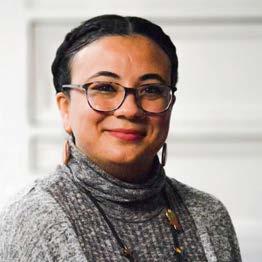
Jackson Dvorak, BSBA 2020, began a new position as a field sales and marketing representative with Techtronic Industries.
McKenzie Roark, BA 2020, began a new position as a paraeducator with the Bremerton School District.
Grace Roberts, BSAcc 2020, began a new position as a financial analysis advisor with Express Scripts.
Melvyn Rollins II, BSBA 2020, MBA 2022, began a new position as an associate banker with JPMorgan Chase & Co.
Bailey Barry, BA 2021, began a new position as a commercial lines processor with DeWitt Insurance.
Joshua Blumm, BSIS 2021, began a new position as a data analyst at Centene Corporation.
Alexis Bradley, BSW 2021, began a new position as a social services coordinator with Silver Tree Residential.
Amber Brown, BLS 2021, began a new position as a program coordinator with Washington University in St. Louis.
Abby Naumann, BA 2019, secured funding as a consultant for The Carter Center to design and implement a first-of-its-kind mental health outreach program for communities affected by displacement and violence in Mali.
Brendan Riesmeyer, BSBA 2019, began a new position as an area sales manager with Pinnacle Climate Technologies.
Cathryn Scoopmire, BS 2019, began a new position as an insurance defense paralegal with Fudge Broadwater.
Rachael Wylie, BSBA 2019, began a new position as a quality assurance supervisor with Harry & David.
Nathan Ackerson, BA 2020, began a new position as an interpreter and UC TFC teacher with Bethany Christian Services.
Allison Belew, BSBA 2020, began a new position as an executive assistant at the University of Missouri–St. Louis.
Matthias Dunville, BSBA 2020, began a new position as a portfolio administration manager with Cushman & Wakefield.
Kendra Clark, BS 2021, began a new position as a talent and OD program analyst with Constellation.
Ginger Edwards, BM 2021, began a new position as a house parent with Ronald McDonald House Charities.
Gabrielle Forchee, BS 2021, began a new position as a data analyst with Premium Retail Services.
Kendall Goodwin, BS 2021, began a new position as a parts specialist with AAA Trailer Services.
Paige Hulahan, BS 2021, began a new position as a category capabilities analyst with Anheuser-Busch.
Justin Humphrey, BSIS 2021, began a new position as an information technology support analyst with Hager Companies.
Jade Johnson, BA 2021, began a new position as a senior manager of recruitment and admissions with Per Scholas.
Olivia Klank, BSBA 2021, began a new position as a growth account executive with G2.
Samantha McClure, BSN 2021, began a new position as a registered nurse with Mercy.

THE MOVIE “FORD V FERRARI” PROVIDED A QUOTE THAT DIDN’T CHANGE MY LIFE, BUT IT HIT ME HARD. “IT’S A TRULY LUCKY MAN WHO KNOWS WHAT HE WANTS TO DO IN THIS WORLD ‘CAUSE THAT MAN WILL NEVER WORK A DAY IN HIS LIFE.”
Lalith Reddy, MS 2023
Bryan McCreary, BA 2021, began a new position as a partner channel manager with Linxup.
Symone Moore, BES 2021, began a new position as a pain access representative with Mercy Hospital St. Louis.
Thomas Moore, BSAcc 2021, began a new position as a senior auditor with Holt and Patterson.
Ryan Rawlings, BSIS 2021, began a new position as a test engineer with Charter Communications.
Charlotte Richards, BSBA 2021, was named one of nine finalists for NCAA Woman of the Year.
Nicholas Schechter, BLS 2021, began a new position as an account manager with The PetCot Company.

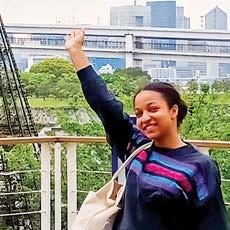
Although she loves St. Louis, Erikah Taylor-Allen can’t deny she feels at home in Tokyo. She’s long been intrigued by the culture of Japan, from the fashion to the history. She studied the language in high school and continued to do so at UMSL, where she earned a bachelor’s in Japanese and a certificate in East Asian studies. She studied abroad in 2018 and again in 2019 and went on to work as a global ambassador for UMSL Global from 2020 through 2021, where she hoped to inspire UMSL students to experience all that study abroad has to offer. As a scholarship recipient, Taylor-Allen wanted students to know they didn’t have to be wealthy to participate, that there were scholarships and financial aid options available. After living in Tokyo for more than a year while working as an English language teacher with Berlitz Japan, she offers these insights and recommendations.
Where you want to stay depends on your interests. If you like the fast-paced city life, love technology or fashion and want to buy anime merch, the city center of Tokyo is a great place to stay. You’ll have easy access to all the major neighborhoods if you stay at a hotel near the Yamanote line. If you would like to see nature or go hiking, Yamanashi and Shizuoka are great places, as you can enjoy the views of Mount Fuji. As for tradition and history, Kyoto and Nara will be your go-to.
Well-known locations like Tokyo Skytree, Tokyo Tower, Sensō-ji in Asakusa and Meiji Jingu in Harajuku are hard to beat but can be quite crowded. For a view of the city, the Bunkyo Civic Center Observation Lounge is free and is only a short walk from Tokyo Dome City. For tradition, the
Tomioka Hachimangu shrine and Fukagawa Fudō-dō temple, both in Monzen-Nakacho, will give you a glimpse into the past without the massive crowds. Kawagoe in Saitama and Kamakura in Kanagawa are perfect locations to take a day trip from Tokyo for a traditional tour.
My favorite food is soba, especially zaru soba (cold buckwheat noodles that are dipped into cold, soy-based broth). I also recommend trying yakiniku (barbecued meat) or going anywhere with fresh fish. Famichiki (boneless fried chicken sold at the convenience store Family Mart) is a quick, juicy and tasty snack when you’re in a hurry. The viral souffle pancakes are fluffy and yummy. Traditional sweets like mochi and dango are also great. For vegetarians, salad bars and vegan spots are becoming more popular as well!
One of my biggest shocks was the attitude toward AI technology here is very different. In many parts of the world, people worry that AI will threaten many people’s positions in creative industries. However, in Japan, where the birth rate is low and the population is declining, technology like this is not only widely embraced but necessary. Many of those who work in corporate positions feel burnt out after working long hours, so many people believe that working with AI can ease their workload. Maybe this is to be expected in a country known for its advancements in robotics and technology, but it is still interesting to hear the difference in attitudes regarding this controversial topic.
The University of Missouri–St. Louis is elevating its mission to transform lives by reimagining the campus experience. Central to this is the creation of a new “front door” to the university: the Richter Family Welcome and Alumni Center. Donors have been inspired to make this dream a reality for students and alumni. Hear from donors why they chose to support UMSL.
“I still want to be a part of UMSL in some way because there’s so much good that’s happening. UMSL has done so much for me, so for me to contribute to the Richter Family Welcome and Alumni Center, that’s the least I can do.”
— Brenda Stith Loftin, BS 1980“Our financial support of the new Richter Family Welcome and Alumni Center speaks to our gratitude to UMSL. UMSL provided us and so many others with a premium education and a wraparound
“It is a privilege to be able to give back to UMSL. The Richter Family Welcome and Alumni Center will be a true marquee for all alumni to find a home on campus.”
— Dave Reifschneider, BSBA 1988, UMSL Alumni Association president

To learn more about how you can make an impact, visit giving.umsl.edu or contact giving@umsl.edu.
Connor Schultz, BS 2021, began a new position as an application developer with onPeak.
Armin Sehovic, BSBA 2021, began a new position as a client relationship consultant with U.S. Bank.
Marissa Smithinsky, MEd 2021, began a new position as a content creator with Hummingbirds.
Mary Alice Swann, BS 2021, began a new position as an assistant facility manager with Cushman & Wakefield.
Erikah Taylor-Allen, BA 2021, began a new position as an English language teacher with Berlitz Japan.
Jennie Tran, BSBA 2021, began a new position on the tax staff with Ernst & Young.
Sean Truesdale, BS 2021, began a new position as a federal loan officer with the USDA.
Nick Tzianos, BSBA 2021, began a new position as a talent acquisition specialist with Lutheran Church Extension Fund.
Dyamond Bradford, BS 2022, began a new position as a junior paralegal with Stone, Leyton & Gershman.
Gabriel Brown, BSBA 2022, began a new position as a senior financial analyst with Amazon.
Jonathan Cochrum, BSBA 2022, began a new position as a senior marketing coordinator of brand ambassador partnerships with Perficient.
Sara Hamer, BSBA 2022, began a new position as a marketing coordinator with Citizens Bank.
Stefaniya Ivanova, BSBA 2022, began a new position as a technical business analyst with Macquarie Group.
Berke Kacar, BSAcc 2022, began a new position as a senior staff tax accountant with UHY.
Clara Lopez Bueno, BSBA 2022, began a new position as an associate project manager in supply chain with World Wide Technology.

Michael WATSON JR., BES 2021, began a new position as youth services director with YMCA of Greater Charlotte. Driven by a passion for making a positive impact on young lives, Watson spends his days assisting children, forging meaningful bonds to help guide them toward a path of success. He feels UMSL played a pivotal role in his career by helping him focus on personal development and thinking beyond oneself while planning for the future. He also credits the university with providing a stepping stone into the professional world with access to experiences and internships that helped begin his career journey. “I’m thrilled about the distinct perspective I bring to my role, coupled with ambitious goals that set a high standard,” he says. “The prospect of forming meaningful connections with the children I engage with, as well as guiding and supporting the staff in advancing their careers, is particularly exciting.”
Anusha Podupuganti, MS 2022, began a new position as a software engineer 2 with Intuit.
Annie Ray, BS 2022, began a new position as a clinical research coordinator with Washington University in St. Louis.
Rachael Rice, MEd 2022, began a new position as an intake specialist with Mercy.
Rebecca Taylor, BSW 2022, began a new position as an association and program manager with Terry Humphrey Public Affairs Group, Inc.
Matthew Argent, BA 2023, began a new position as an assistant store manager with GameStop.
Jordan Fortner, BSBA 2023, began a new position as an associate product manager with TAG, Inc.
Maisoon Hamed, BSBA 2023, began a new position as a marketer operational specialist with Abstrakts.
Dana Lynn Kerns, BS 2023, began a new position as an employment specialist with the Independence Center.
Shelby Long, BS 2023, began a new position as a trauma registrar with SSM Health Cardinal Glennon Children’s Hospital.
Katie Loomis, BSBA 2023, began a new position as a buyer with Bunzl Distribution North America.
Renee Patrick, BS 2023, began a new position as an IT support technician with Orbital Engineering, Inc.
Bri Petty, BS 2023, began a new position as a quality control scientist I with Thermo Fisher Scientific.
Lalith Reddy, MS 2023, began a new position as a data analyst with CarShield.
Jenna Teeter, BSBA 2023, began a new position as a nursing assistant with Webb City Health and Rehabilitation Center.
Jackson Zamora, BSBA 2023, began a new position as a logistic analyst with Anheuser-Busch.
THE RELATIONSHIPS. THOSE WITH MY PROFESSORS WHO HELPED SHAPE MY CAREER AND SUCCESS IN BUSINESS. THOSE WITH MY PEERS WHO IMPACTED HOW I SEE THE WORLD AND THE LIFELONG FRIENDSHIPS THAT WERE FOSTERED. THOSE IN THE SURROUNDING COMMUNITY WHO INTRODUCED ME TO THE BEAUTIES OF DIVERSITY AND CIVIC PRIDE.
Billy D. Dickens III, BSBA 2003
Arielle Wynn, BSW 2021, began a new position as a foster care specialist with Saint Louis Public Schools.
Andrew Ziggas, BS 2021, began a new position as an Artiva developer with State Collection Service, Inc.
Sanel Zulic, BSBA 2021, began a new position as a client care advocate/Tier 1 technical support specialist with Facilisgroup.
d— 1960s Dennis McCarthy, BA 1968, on Oct. 9, 2023 — 1970s John Getz, BSBA 1974, on July 24, 2023; Bob Franklin, BSBA 1978, on Jan. 23 — 1980s Kenneth Francis Thomas, BA 1980, on Sept. 22, 2023; Kathleen Baragiola, BSBA 1983, on June 26, 2023; Gordon Bardos, BA 1988, on Jan. 8; Barbara Christine Bentrup, BSBA 1989, on June 7, 2023
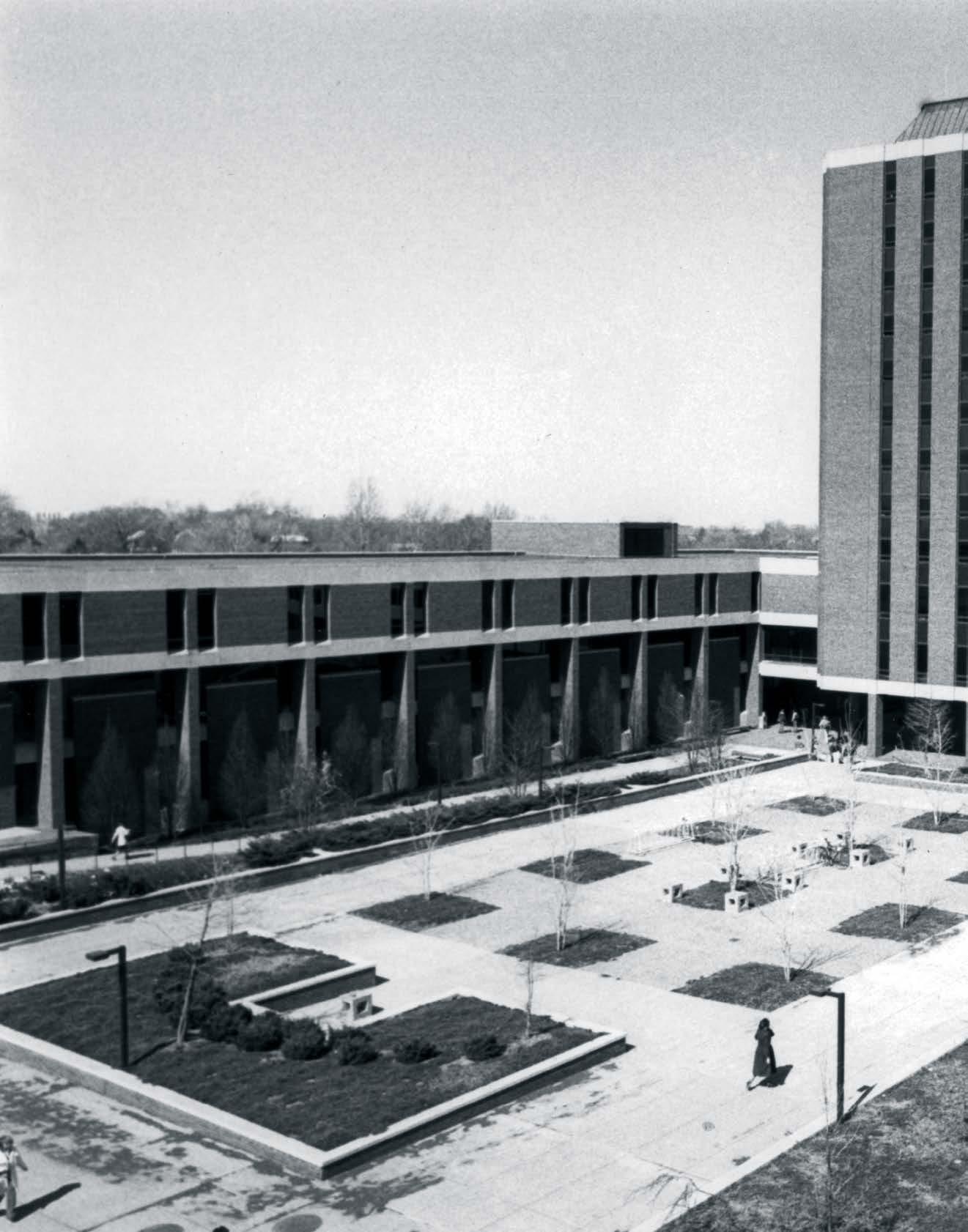



2024181.108,946.4/23.wa/mb/tm.walsworth
giving.umsl.edu/scholarship
giving@umsl.edu
Since its founding in 1963, the University of Missouri–St. Louis has transformed lives by making higher education more accessible, allowing students from all backgrounds to grab hold of their futures.
The UMSL Scholarship Fund is critical in helping to meet that need. For students who find themselves struggling financially, scholarships large and small can mean the difference between dropping out or completing their educational journey.
You can make a difference today. Every dollar you give in support of scholarships will help a student get one step closer to the future they want for themselves and their families. Help build inclusive prosperity and growth for everyone. Please support the UMSL Scholarship Fund today!